

根据中国记协《中国新闻奖评选办法》,经中国日报社各采编部门、各驻地方机构、各驻海外机构等推荐,并经过社内部评审、编委会集体审议,社领导批准,拟推荐9件新闻作品参评第三十一届中国新闻奖。
现对9件申报作品予以公示,公示期为5月24日至5月28日,如有异议,可通过电话、电子邮箱等方式向中国日报反映。
电话:010-64995424
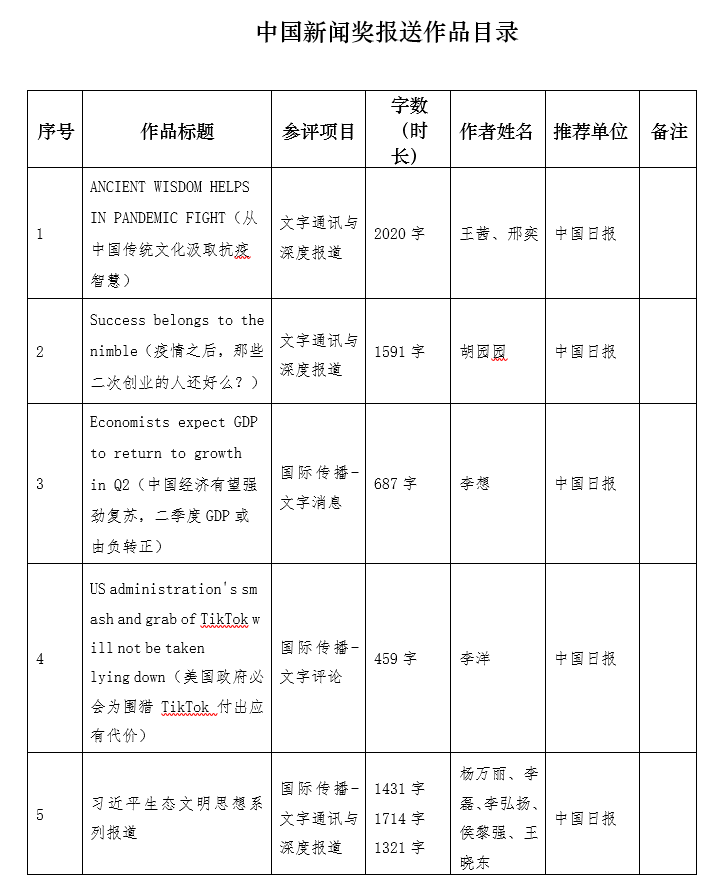
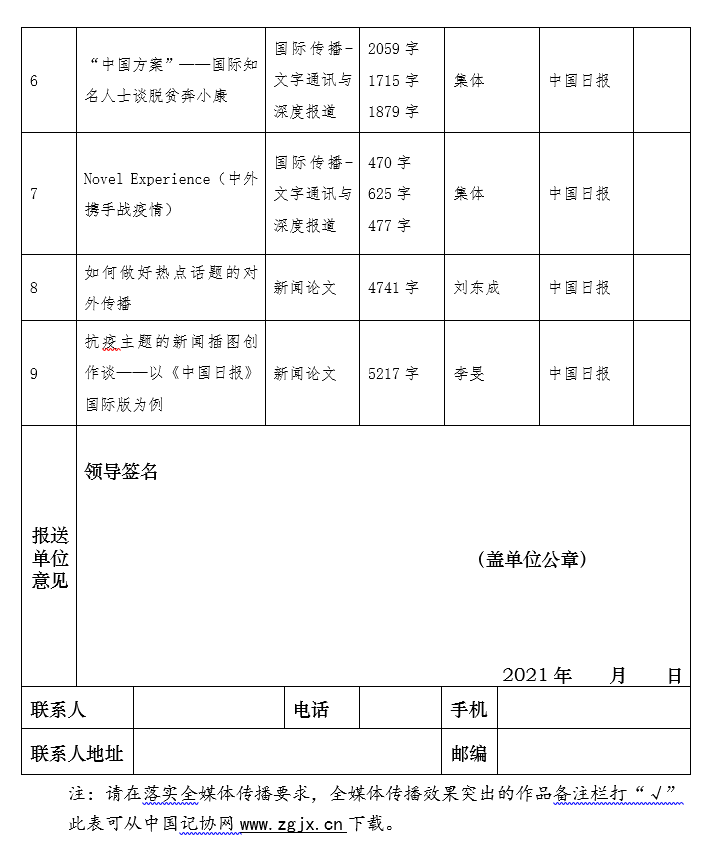
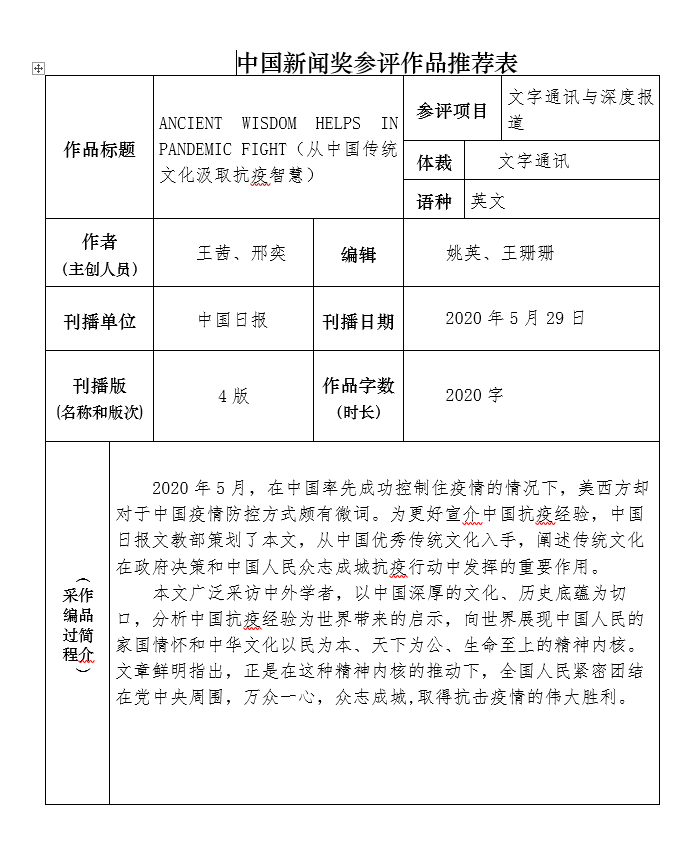
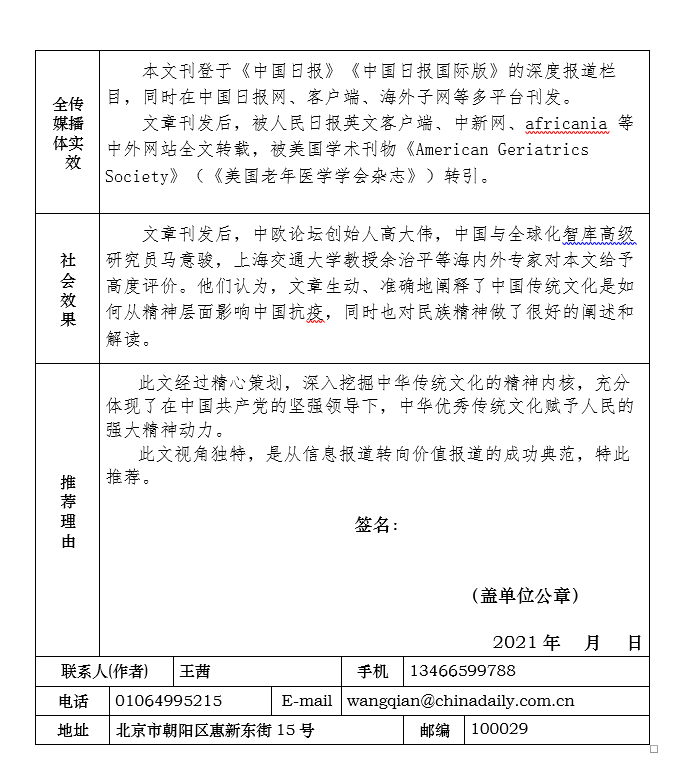
原文
Ancient wisdom helps in pandemic fight
By WANG QIAN in Beijing and XING YI in Shanghai | China Daily |
Traditional culture playing a vital role
The COVID-19 pandemic has largely been brought under control in China, with many scholars believing that traditional culture has played an important role in shaping people's response to it.
In February, after a field investigation to Wuhan, Hubei province, by the World Health Organization, assistant director-general Bruce Aylward said China had demonstrated phenomenal collective action and a cooperative spirit in fighting the virus.
"Behind every window in every skyscraper, there are people cooperating with this response," the Canadian epidemiologist said.
Speaking at a recent edition of Vision China organized by China Daily and Tsinghua University, Aylward said Chinese people's sense of social responsibility, which is embedded in the nation's culture, and their experiences in fighting the severe acute respiratory syndrome, or SARS, outbreak in 2003 are key elements of the country's efforts to tackle the virus.
David Gosset, founder of the Europe-China Forum, said "the cultural element is of the greatest importance" in such a unified and rapid response.
"In the Chinese context, it can be said that traditional values inspired by Confucianism... helped China in its battle against COVID-19," Gosset said.
"Culture has been underestimated by commentators, while it has arguably played the most important role in shaping global reactions to events.
"Less visible than economic dynamics or even political structures or processes, culture is nevertheless what determines the behavior of individuals."
Four factors in traditional philosophy-dayitong (great unification), jiaguo tonggou (family and state are the same), filial piety and tianxia (all under the heaven)-have influenced the country's response to the pandemic, according to scholars.
Mario Cavolo, a non-resident senior fellow at the Center for China and Globalization, said,"In a further examination of the values at the root of achievements (made in the fight against the pandemic), we find a historical source driving values, attitudes, and ultimately, our behavior.
"In Europe, for example, we find Judeo-Christian ethics and religions, while some countries prefer a more post-Modern Era neoliberal set of values," he said.
Gosset said,"As a major global crisis, this pandemic has revealed many aspects of our modernity, and certainly that the world is not culturally uniform. It has indeed to be understood as the juxtaposition of several different cultural contexts."
Great unification
The Confucian concept of dayitong means a common pursuit or respect for unity. Traceable to Confucius, Mencius and other philosophers, it was elaborated on by the philosopher Dong Zhongshu (179-104 BC).
From the Han Dynasty (206 BC-AD 220) onward, ancient China saw its most prosperous period, in which the benefits of Confucian civilization were spread to the rest of the world.
Yu Zhiping, philosophy professor at Shanghai Jiao Tong University, said, "This influence can still be felt in China today, which is helping the Chinese people win the coronavirus war.
"The dayitong concept, which still influences Chinese political culture, has made such an unprecedented mobilization of nationwide resources possible."
Since a lockdown was enforced in Wuhan on Jan 23, unparalleled nationwide mobilization efforts have been made to combat the pandemic.
Two days later, under President Xi Jinping's command, a central leading group on epidemic response, headed by Premier Li Keqiang, was established. On Jan 27, a central working group led by Vice-Premier Sun Chunlan was sent to oversee work in Hubei.
On Feb 10, the National Health Commission launched an assistance plan, with 19 provinces providing support to cities in Hubei.
According to official data, some 43,000 medical workers risked their lives to help the province.
Two makeshift hospitals-Huoshenshan and Leishenshan, with a total capacity of 2,600 beds-were quickly built and started treating COVID-19 patients in early February.
Following the efforts made in Wuhan, most cities nationwide adopted strict measures to minimize the movement of people.
Canadian political science professor Daniel A. Bell said that with the experience gained in fighting SARS, Chinese people know that when social order faces a severe threat, a strong, collective and efficient government is needed to take decisive action.
Bell, dean of the School of Political Science and Public Administration at Shandong University and professor at Tsinghua University, made the comments in a recent interview with the website of the Communist Party of China's Central Commission for Discipline Inspection.
A global crisis perception index released last month by social research agency Blackbox Research and consumer intelligence platform Toluna supports Bell's assessment. It found that China had the highest-rated leadership among 23 nations, with the country scoring 85 points out of 100.
Conducted over 16 days from April 3, respondents were asked to rate their countries through four key indicators: national political leadership, corporate leadership, community and media.
Families and nation
In addition to the whole-nation system, Bell highlighted the spirit of cooperation among Chinese people fighting the virus.
He said that in traditional Chinese culture, citizens feel obligated to serve their families and the nation.
Yu, from Shanghai Jiao Tong University, said this is the ideal of jiaguo tonggou, which means that family is a reduction of the state, and the state is an amplification of the family.
"In Chinese families, parents have the authority to make decisions and children should follow them," he said.
"In cultural terms, we take the country as our family, and when the government declared a war on the deadly pneumonia, millions of people from all walks of life, including civil servants, medics, community workers and volunteers, risked their lives to fight on the frontline."
By inheriting ancient wisdom, Chinese have a hardwired willingness to sacrifice individual freedom and undergo hardships for the sake of common well-being, Yu said.
"To lock down a huge city like Wuhan, with a population of over 11 million people, is unprecedented. With the support of the public and its willingness to comply with government orders, China succeeded."
Bell said that by sacrificing part of their freedom and privacy temporarily, people-with Confucian culture deep in their hearts-were willing to comply with the government's quarantine measures, because they trusted the authorities to make the best decisions.
When the Wuhan lockdown was imposed, all public transportation and business halted, with residents ordered to stay indoors to reduce transmission of the virus. The lockdown was lifted last month, with business in the city gradually returning to normal.
The concerted response to the measures taken in Wuhan bear testimony to a Chinese proverb that states, "When people are of one mind and heart, they can move Mount Tai." (The mountain is a landmark of cultural and historical significance north of Tai'an, Shandong province.)
Bell said that in times of crisis, "the collectivist orientation perspective has its benefits, compared with individual orientation".
As China fought the virus, non-governmental organizations and overseas Chinese donated urgently needed protective equipment, including face masks, surgical gowns and goggles, to support epidemic prevention and control measures.
Tens of thousands of manufacturers nationwide quickly reconfigured production lines to make medical masks to meet surging demand at home and overseas. The country's daily output of masks rose from 8 million on Jan 25 to 116 million on Feb 29.
Meanwhile, technology companies, including Alibaba and Tencent, have created apps to help the public cope with confinement.
Gosset, from the Europe-China Forum, said, "The effectiveness of Chinese governance, combined with a culture in which individuals put collective responsibility above all, can explain why China has been able to manage a highly dangerous situation."
Filial piety
As the outbreak in China developed into a global pandemic, many countries encouraged the elderly and those with severe medical conditions to stay at home, as they faced a higher risk of contracting COVID-19.
With hospitals around the world unable to cope with a surge in the number of patients needing treatment for the disease, debate arose over whether medics should give priority to younger patients.
However, Bell said that in China-a country deeply influenced by Confucianism, with filial piety its core virtue-strong measures have been taken to protect seniors from the disease.
Filial piety, or xiao, means to respect, obey and care for the elderly, highlighted in ancient and authoritative classics such as The Analects of Confucius and The Classic of Filial Piety (Xiaojing), along with works by Mencius.
According to a frequently quoted saying by Mencius,"Treat all elders as you would respect your own; love all children as you would love your own."
Tang Bei, a professor specializing in global health governance at Shanghai International Studies University, said, "This virtue has been a constant theme in China's COVID-19 response, which includes all-out efforts to provide testing and treatment for all those in need, no matter whether they are young or old."
In the fight against the contagion, the Chinese leadership has continued to emphasize that people's lives, safety and health are the top priorities.
Tang said, "This is people-orientation, an important ethical requirement in the public health field, especially in making epidemic prevention and control policy."
China's response to the pandemic is largely shaped by its ancient philosophy of ethics, which has greatly increased people's trust in the government, the professor said.
Tang quoted from the Confucian classic The Book of Documents, or Shangshu, which states, "The people are the root of a country; when the root is firm, the country is tranquil."
As of April 6, the average total cost of treating a hospital patient with COVID-19 was 21,500 yuan ($3,038).
For severe cases, the average minimum cost was 150,000 yuan, with the overall charges for treating some critical cases reaching more than 1 million yuan, according to the National Health Commission. All such expenses are covered by the country's healthcare insurance system and government budget.
Official data show that as of last month, Wuhan had registered more than 50,000 patients with the virus-about 2,500 of them age 80 or older. The oldest patient who recovered is 108.
Global community
While taking good care of its citizens at home, China has offered help to nations severely affected by the pandemic.
The sudden emergence of the virus has served to remind the world that, in the era of globalization, all countries' interests are closely interconnected and society has a shared future.
The concept of a shared future is similar to the notion of tianxia (all under the heaven), which embodies a worldwide public perspective rooted in Confucian moral and political thinking.
In Liji (The Book of Rites), translated by the Scottish Sinologist James Legge, Confucius states, "When the grand course was pursued, a public common spirit ruled all under the heaven."
Cavolo, from the Center for China and Globalization, has lived in China for two decades and witnessed the country's fight against the pandemic in Shenyang, capital of Liaoning province.
The Italian-American, who remains deeply concerned for his family and relatives in the United States, said: "In essence, we are all connected. We are all part of the same glorious community, and each individually responsible for what we do to shape that community."
This community transcends ethnicity or sovereign borders, and in this sense, people are experiencing a unifying challenge as they face the pandemic," he said.
The Confucian vision of an ideal society envisioned a world characterized by harmony and cooperation, which President Xi has mentioned several times.
In 2015, Xi took the podium at the UN to speak of "a community with a shared future for mankind". He elaborated on this later, saying that an ideal world would be one that is safe, prosperous, open, orderly and inclusive.
On May 18, Xi announced at the virtual opening of the 73rd session of the World Health Assembly that China would provide $2 billion over two years to help with the COVID-19 response and with economic and social development in countries affected by the virus, especially developing nations.
Xi also said China is ready to work with the international community to bolster support for the hardest-hit countries.
Igor Shatrov, deputy director of Russia's National Institute for the Development of Modern Ideology, told Xinhua News Agency the pandemic is a serious test in which "humanity must realize that we live in a single world and have a common destiny, so it should unite in the face of a global threat".
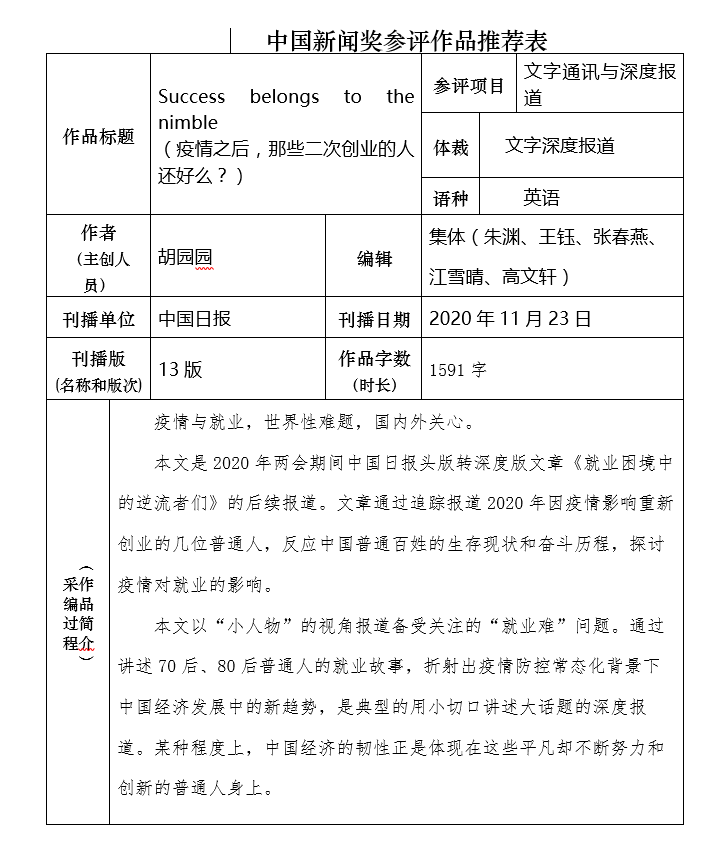
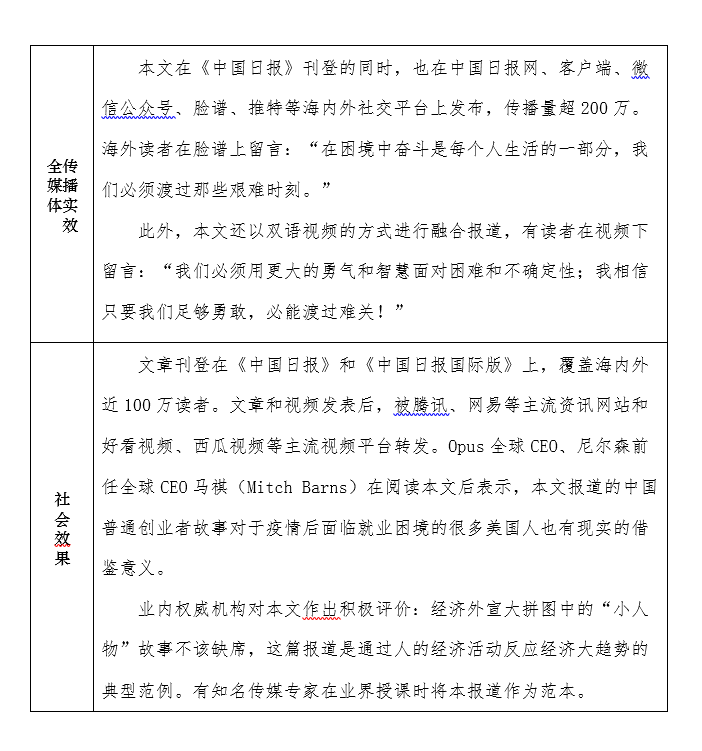

SUCCESS BELONGS TO THE NIMBLE
By HU YUANYUAN
It will go down as the year of disruption and dislocation, one in which, because of the pandemic, planning ahead often seemed to be a pointless exercise.
For proof of that you need to go no further than small business owners, who this year have needed to abandon old ways and be innovative and nimble enough to adapt in a flash to changing conditions.
One of those owners is Zhou Yiyan, who at the start of the year ran a studio in Shanghai specializing in decluttering and better home organization, but which by November had gone through a couple of reorganizations and reincarnations of its own.
The first of those came in early March, a few weeks after the pandemic broke out and lockdowns and social distancing measures were imposed throughout China. At a time when other companies were still running on idle, the studio received a lucrative order from the property developer Vanke, which was looking to reorganize the allocation of apartment space to take account of customers' health-related concerns, including allowing more room for storing items related to epidemic prevention.
This kind of work looked like delivering Zhou a healthy profit stream as she secured contracts from other property developers.
However, that turned out to be illusory because some of these companies have been in tough financial straits themselves, and were extremely slow in paying money due to her. In addition, the number of those paying membership fees to the studio for online training courses slumped, and Zhou said that so far this year, the studio's profits had fallen 20 percent compared with the same period last year.
"When we tried to expand our better home organization services from property developers to more individuals, we found it difficult. Most people are more willing to pay for interior designers or interior decorators."
As November and Singles Day on the 11th loomed, Zhou had a flash of inspiration, thinking about the origins of what has become an occasion for hundreds of millions of people to go bargain-hunting on the internet.
In fact, well before the world of commercialism caught up with Nov 11 in a big way about 10 years ago, it used to be a kind of Valentine's Day, the date's digits representing those who are unattached and supposedly lonely-or possibly not.
Zhou's idea was essentially a marketing one, to tailor her online courses on decluttering to middle-aged single women and to do so through her WeChat Channels as Nov 11 loomed.
The Ministry of Civil Affairs said that in 2018 there were 240 million Chinese of marriageable age who were either single or divorced. Considered as a market, that figure is all the more tantalizing when you consider it is greater than the combined population of France, Germany and the United Kingdom.
Zhou, 36, herself single, said those who belong to this group are strongly motivated to please themselves whether by making themselves look more beautiful, making themselves feel better-or possibly even relieving any anxiety some may have about being single.
"We used to help people better organize their homes, but we've been shifting our focus from decluttering the outside to decluttering the inside, the latter being something single women will increasingly want," Zhou said, "the inside "referring to matters psychological as much as physical.
"So we're trying once again to change our focus, and the emergence of WeChat Channels has provided us a good chance in doing that."
WeChat's owner Tencent launched the new video platform in March, looking to it as a powerful tool that could help the content publisher reach 1.2 billion WeChat users. And with WeChat's huge user base, its influence may eventually surpass that of Douyin, the original, domestic version of the video platform TikTok.
Another small business owner who has had to quickly adapt to changing conditions as he navigated the difficult shoals of the pandemic is Sun Mingzhe, 41, who worked in IT in Beijing for 20 years before opening, with several other investors, three medium-sized restaurants named Daddy Shrimp last year.
As the restaurant industry felt the full brunt of the pandemic in the first half of this year, the three restaurants were forced to close, and investment of more than 3 million yuan ($456,660) was washed down the drain.
In March Sun took a fresh look at his approach to business and set up a community catering service. This involved delivering popular fast foods such as spicy crayfish and lamb spine to neighbors, in tune with the lockdown zeitgeist of reducing personal contacts and dining at home rather than out. Sun later also set up a kitchen to offer family packages and healthy meals, in addition to the existing fast-food products.
"I rented a kiosk near my community for about 15,000 yuan a month," he said. "I've had gross profit of about 30,000 yuan a month, and if everything goes smoothly, I'll be breaking even in two to three months," Sun said in an interview in May.
However, again reflecting the unpredictable times, the pandemic in China ebbed just as Sun's business was about to break even, and demand for community catering services slumped.
"Nevertheless, I built up a customer base for the several months I ran the catering delivery services. I then switched from fast food to special local products, such as lamb slices from the Xiliin Gol grassland in the Inner Mongolia autonomous region and potatoes from Zhangjiakou in Hebei province."
Sun has now taken on the mantle of "Delicious Food Mover for Communities", managing 16 WeChat groups that cover 11 communities in Wangjing area of Beijing, with an average of about 300 people in each group.
Therein lies the trick, for group purchasing power is not to be sniffed at, Sun said. For example, he sold his full inventory of more than 100 free-range chickens from Inner Mongolia within two weeks.
"The online group purchase mode gives small concerns from second-and third-tier cities a chance to enter big markets at low cost, and is also a win-win deal for group purchase managers, customers and local special producers," Sun said.
His WeChat groups helped farmers in Zhangjiakou sell more than 1,000 kilograms of potatoes in the first 10 days or so of November, and by the end of the month that figure is expected to be 3,000 kg.
"Local wholesalers usually pay farmers 0.4 yuan to 0.6 yuan for half a kilogram, and we pay them about 1.2 yuan," Sun said. "They retail at 3 yuan for half a kilogram, compared with the average market price of 7 yuan."
For WeChat group purchase managers, the most attractive thing about the business model is the very low cost, important especially in times such as these.
Sun said he usually opens the group purchase program on work days, with the program counting the number of people who have placed orders. Customers have enough trust in him to pay for goods in advance, and Sun buys the local specialties with those funds and delivers on weekends, meaning there is no capital outlay.
The biggest challenge, Sun said, is to find suppliers of local specialties of very good quality and that are strongly competitive.
In addition to expanding the quality products he offers to group customers, Sun is cultivating his personal account on Douyin, hoping to try livestreaming e-commerce, thus he can combine the offline mode with the online one.
"It's been extremely difficult for me this year, but you have to keep on trying and seizing every opportunity that comes along and go for it. Otherwise the chances for success will drift away."
In these straitened times, livestreaming is a marketing avenue small business owners have latched onto, a method that a recent report by Nielsen said is supported by innovative online channels and the accelerated shift toward online consumption.
The annual value of livestreaming e-commerce is likely to be 961 billion yuan this year, or about 10 percent of all e-commerce in China, the report said, with 265 million users, accounting for 47.3 percent of livestreaming users.
Zhang Chenggang, an associate professor at the Capital University of Economics and Business in Beijing, said that the number of people engaged in new occupations, such as online shop planner and digitization service provider, has rocketed. With a flexible mode, new professions are playing an increasingly important role in creating jobs.
From January to September, 8.98 million new urban jobs were created, almost reaching the annual target of 9 million in this year's Government Work Report. The surveyed unemployment rate in urban areas was 5.4 percent in September, compared with the year's target of about 6 percent, the Ministry of Human Resources and Social Security said.
Meng Qingwei, deputy director of China Talent Research, said market demand based on technological innovation and social changes are leading to new occupations. Sixteen new occupations have been identified by the China Employment Training Technical Instruction Center, part of the Ministry of Human Resources and Social Security, this year.
Zeng Xiangquan, director of the China Institute for Employment Research at the Renmin University of China in Beijing, said flexible employment, in which employees are not bonded with a particular employer but are free to earn income from multiple employers as matched by a public platform, has great potential.
The internet company Alibaba, for instance, has 110,000 employees but has spawned more than 40 million jobs including online retail vendors and couriers, according to industry figures. The digital cultural platform China Literature has only 1,300 workers but has 8.9 million literature creators.

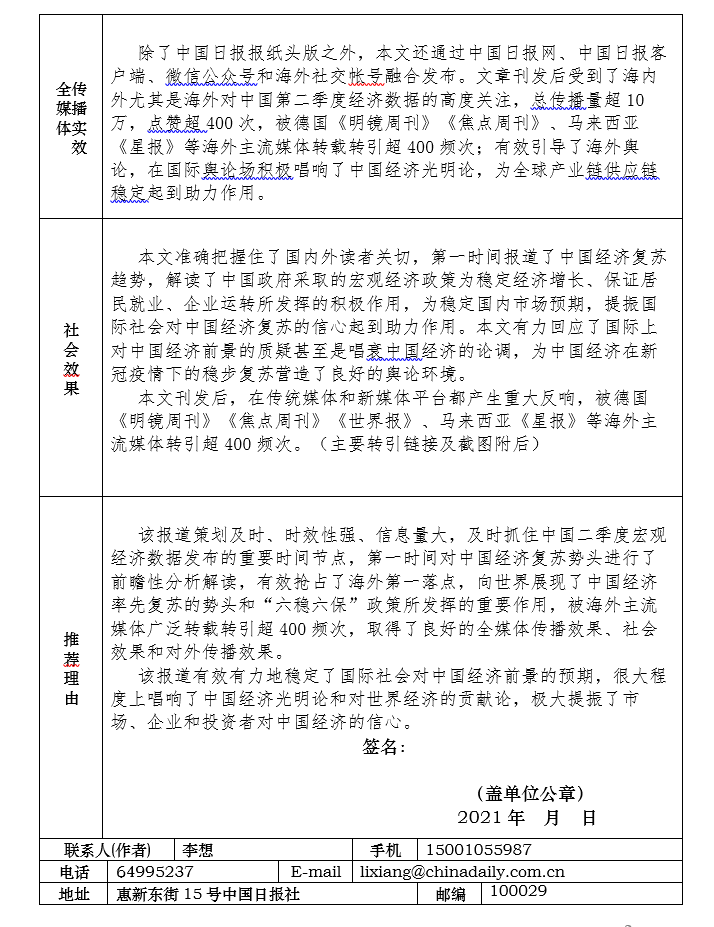
Economists expect GDP to return to growth in Q2
By LI XIANG | CHINA DAILY |
China's economy may return to the expansion mode from the second quarter after a sharp contraction in the first quarter, and the country's policies will remain supportive for the rest of the year to help the economy advance steadily out of the COVID-19 pandemic, experts said.
The country is scheduled to release a set of key economic data this week on second-quarter GDP, trade, investment, industrial production and retail sales.
While the government has abandoned setting a specific growth target for this year, much attention remains focused on the second-quarter GDP growth rate as it will shed light on the outlook for the world's second-largest economy and Beijing's future policy direction.
Most economists expect the country's GDP growth rate to turn positive in the second quarter with some projecting growth as high as 3 percent, a sharp rebound from the 6.8 percent contraction in the previous quarter.
The optimistic views reinforced expectations that China's economic recovery will continue in the coming quarters, driven by further improvement of domestic demand and investment along with continuous policy support in key areas including employment and corporate operations.
Some economists forecast that China's GDP growth could rebound to around 6 percent in the second half of the year and the country may achieve full-year growth of around 2 to 3 percent.
The recent economic data continued to indicate that China's economy is recovering strongly as both the official and private purchasing managers indexes for the manufacturing and services sectors showed strong expansion in June compared with the previous month.
The country's industrial production is expected to continue to edge higher while the contraction in retail sales is expected to narrow to around zero in June from-2.8 percent in May. Growth in fixed-asset investment will remain robust with infrastructure investment expanding at a double-digit rate thanks to abundant government funding, economists said.
"Economic recovery should continue, following the recent rebound in the second quarter. Domestic consumption will likely improve further with continued policy support and the normalization of economic activity," said Wang Tao, chief China economist at Swiss bank UBS.
"We expect policies to remain supportive while the continued recovery lately has reduced incentives for greater stimulus in the short term," Wang said.
The People's Bank of China, the nation's central bank, said on Friday that it will withdraw its special-time monetary policy after fulfilling the objectives amid the COVID-19 outbreak, but this does not mean a shift in the overall direction of monetary policy or a weakening of support for the economy. The policy outlook will remain prudent and flexible by focusing on providing appropriate funding to support economic growth in the second half of the year, said the PBOC.
Economists warned that the better-than-expected rebound does not mean that China's economic recovery will be plain sailing as headwinds and uncertainties remain in the second half of the year.
Wang Jun, chief economist at Zhongyuan Bank, said that the difficulties facing the country's smaller businesses and low-income families may drag down the economic rebound in the second half of 2020.
Wang said that China's fiscal policy support needs to intensify in the second half of the year to ensure sufficient funding for major projects and the protection of people's basic livelihoods. Meanwhile, monetary policy will be more targeted to help lower funding costs for smaller businesses, as there have been signs of marginal policy fine-tuning by the central bank, he added.
The uncertainties resulting from China-US disputes in trade and the technology sector and the decline of the global economy may also pose risks for China as these factors could hit the country's exports. In addition, the possibility of a re-escalation of the COVID-19 pandemic as the weather cools down in the third and fourth quarters also means that policy easing may step up again, economists said.
"We should not underestimate the destruction caused by the pandemic on the global value chain, and China will need to continue its policy support to shore up demand, expand investment and adjust its export structure to ensure stable growth," said Xu Hongcai, deputy director of the China Association of Policy Sciences' economic policy committee.
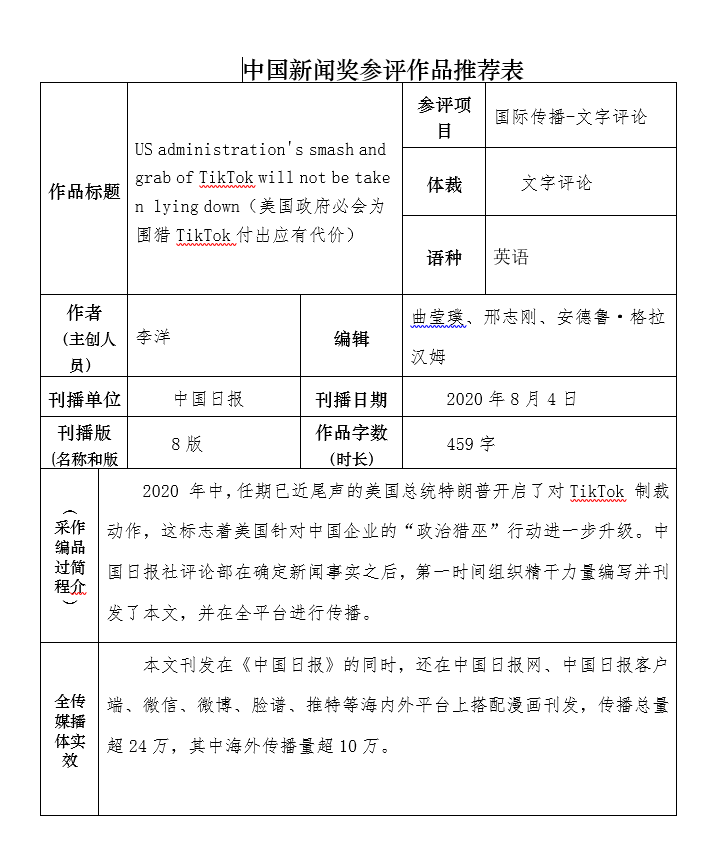
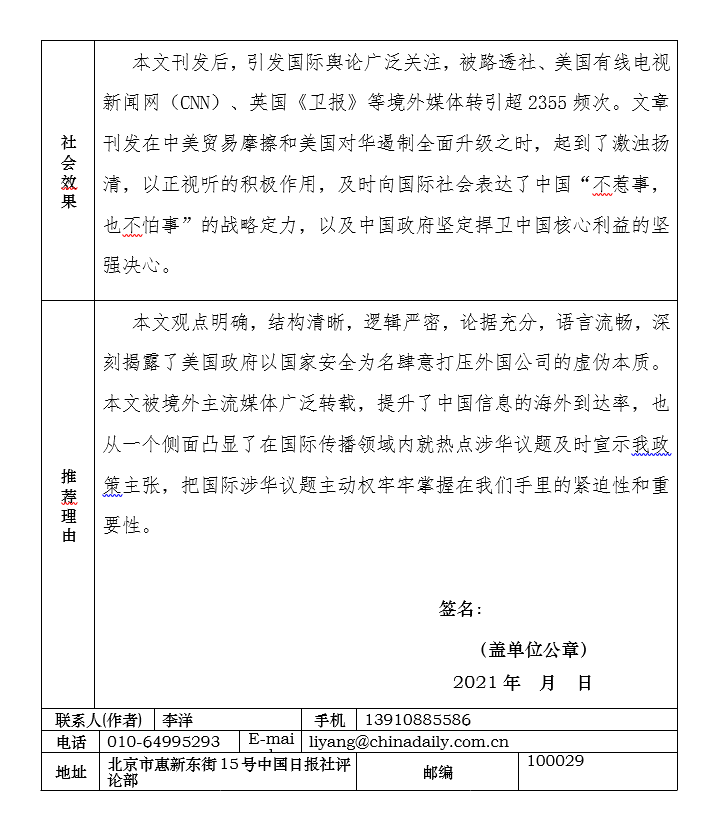
US administration's smash and grab of TikTok will not be taken lying down
After vowing to ban the popular short-video sharing app TikTok in the United States on Friday, the White House is reportedly weighing the advantages of allowing Microsoft to purchase its US operations.
Such shilly-shallying is a tactic the US administration employed during the trade deal negotiations with China.
The tactic involves the White House promising punishment for some perceived wrongdoing, followed by indications from other administration officials that the punishment might not be forthcoming. This is followed soon after by some close to the president saying that he intends to make good on his threat, sparking a sharp rise in tensions again. All with the aim of getting what the US administration wants.
So it was par for the course that after the ban on TikTok was proposed and then left hanging, that US Secretary of State Mike Pompeo told the media on Sunday morning that the president "will take action in the coming days with respect to a broad array of national security risks that are presented by software connected to the Chinese Communist Party".
Although it is yet to be known how that will work, the message will certainly heighten the concerns of Chinese companies.
As TikTok's experience shows, no matter how unfounded the claims against them are, as long as they remain Chinese companies, they will be presented as being a "Red threat" by the administration. That being said, selling its US operations to Microsoft might be preferable for ByteDance, Tik-Tok's parent company in China, as it is working "for the best outcome". And that being the case, the top US diplomat's comments on Sunday were tantamount to inviting potential US purchasers to participate in an officially sanctioned "steal" of Chinese technology.
Washington is well aware that Beijing will be cautious about retaliating like-for-like as it values foreign investment in China, and the sizable US investment in China is of more importance to the Chinese economy than the much smaller and shrinking Chinese investment is to the US economy.
Also, there is the additional bonus that coercing Chinese companies to divest their US business to US enterprises will not incur job losses.
The US administration's bullying of Chinese tech companies stems from data being the new source of wealth and its zero-sum vision of "American first". With competitiveness now dependent on the ability to collect and use data, it offers an either-or choice of submission or mortal combat in the tech realm. There are no carrots to promote cooperation only sticks.
But China will by no means accept the "theft" of a Chinese technology company, and it has plenty of ways to respond if the administration carries out its planned smash and grab.
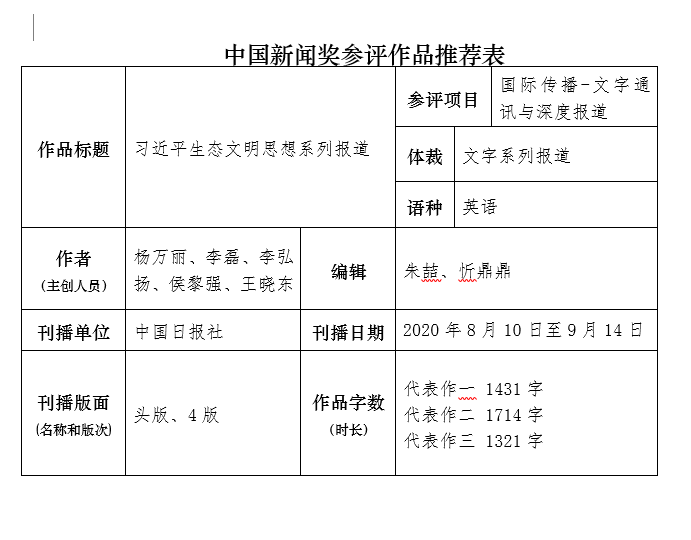
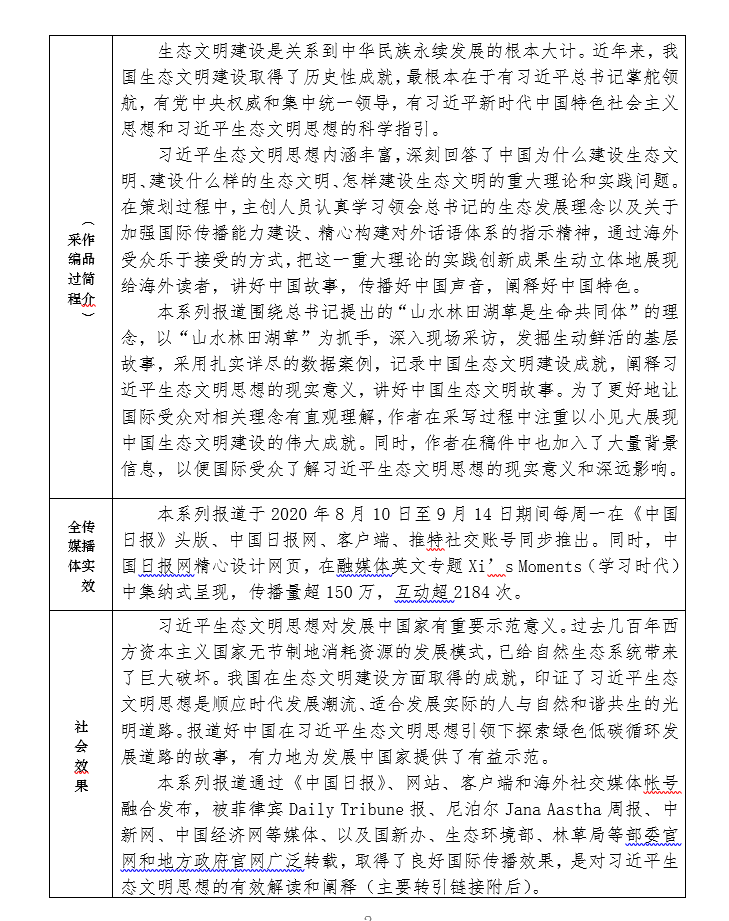

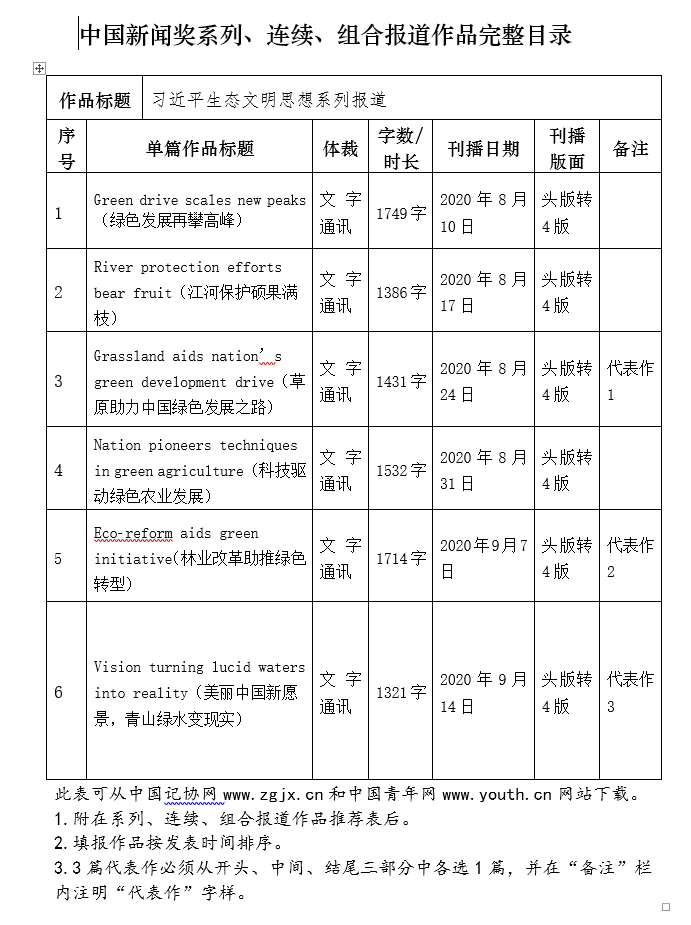
代表作1:
原文:
Grassland aids nation's green development drive
By YANG WANLI in Beijing and YUAN HUI in Hohhot
Ting Baatar, a herdsman from the Inner Mongolia autonomous region, had no reservations when it came to suggesting changes to traditional grazing practices that have helped restore and protect the grassland ecosystem.
Raising sheep used to be the lifeblood of tens of thousands of herdsmen in Saruultuya Gastaa, in Inner Mongolia's Xiliin Gol League, but the animals took a tremendous toll on the environment.
The solution Ting, 65, suggested was switching to raising beef cattle-an industry that now has bright prospects.
During the second session of the 13th National People's Congress, the country's top legislature, in March 2019, President Xi Jinping, who is also general secretary of the Communist Party of China Central Committee and chairman of the Central Military Commission, participated in a discussion held by deputies from Inner Mongolia.
Xi said the region's environment should be protected firmly and strictly, without any exceptions. He also called for stronger protection efforts in line with the principle of working out measures that suit local conditions.
"We should explore new ways for high-quality development, which prioritize ecological protection and the green economy," Xi said. "More efforts should also be made to protect the ecosystem and guard the beautiful scenery on China's northern border."
Rich resources
China is a country rich in grassland resources. Its natural grasslands, the world's biggest, cover an area of 3.92 million square kilometers-12 percent of the global total-according to the National Forestry and Grassland Administration.
The country's grasslands occupy more than 40 percent of its total land area-even larger than the combined area of farmland and forests, said Liu Jiawen, deputy director of the administration's Grassland Surveillance Center.
However, the grasslands suffered from serious overgrazing, leading to degradation and desertification in the 1980s.
Overgrazing, drought and insufficient protection resulted in severe degradation and desertification in Xiliin Gol League. In Saruultuya Gastaa, 70 percent of the grassland suffered from degradation.
Grassland degradation is a biotic disturbance in which grass struggles to grow or can no longer exist due to factors such as overgrazing, the burrowing of small mammals and climate change, said Gao Wenyuan, a researcher at the Inner Mongolia Grassland Work Station.
"Initially, only patches of grass appear to die and turn brown," he said. "If the condition is not controlled from the beginning, the degradation will soon spread to more land. In some severe cases, the land will be laid bare."
He said a typical case was in neighboring Horqin, long famed for its beautiful grassland landscape but now the country's largest expanse of sandy land, which grew rapidly from 423,104 sq km in 1959 to 611,104 sq km in 1987. Thanks to recent rectification efforts, it now covers 408,000 sq km.
Grazing zone limited
To prevent grassland desertification, China's central government has prohibited grazing in some areas and placed limits on the practice in others.
Action taken by the Inner Mongolia Forestry Department in the early 1980s included limiting areas where grazing was allowed and encouraging the feeding of livestock with fodder.
Ting responded quickly, fencing off about 20 hectares of his grassland in 1986. The next year, the forage on this rested land had almost tripled, and many herding families decided to follow his lead.
But Ting soon realized that this was not a permanent solution.
"Feeding livestock with fodder is very demanding in terms of cost and the labor required," he said. "More importantly, meat from livestock raised on grassland has a reputation for tasting good and being nutritious due to the traditional way of grazing. We needed to figure out new ways that maintained the meat's high quality."
Through practice, Ting noticed that to reduce the pressure on the grassland, villagers first needed to reduce the number of livestock and then raise more beef cattle, whose grazing causes less damage than sheep because they do not crop the grass as closely.
"The profit from selling a steer was also almost five times higher than for a sheep," he said.
He sold all 400 of his sheep and switched to beef cattle. He also successfully developed tourism and the dairy and beef-processing industries to boost the local economy, which, in turn, encouraged more people to follow in his footsteps.
Nearly 80 percent of the herdsmen in Saruultuya Gastaa now raise beef cattle. When Ting retired as the village's Party secretary in 2015, its annual per capita income had risen to 18,000 yuan ($2,560)-up from barely 40 yuan two decades before.
In 2016, almost half the land in Xiliin Gol League was covered by vegetation, more than double the amount just 15 years earlier.
Concerted efforts
Action to protect grassland has spread nationwide. Since 2011, a total of 13 provinces and autonomous regions have implemented preferential policies to give subsidies to herdsmen who stop raising livestock on grassland and have placed limits on grazing areas.
Between 2013 and 2017, more than 82,000 cases of illegal use of grassland and illegal grazing were handled nationwide. The number of grassland rangers has also continued to rise, hitting 200,000 by the end of 2017, according to the National Forestry and Grassland Administration.
Free training in various skills has been provided by governments to encourage herdsmen to make money by tapping the green economy, such as eco-friendly tourism or the planting of lucrative herbs.
Since the 18th CPC National Congress in 2012, ecological civilization has been listed as one of China's five major goals in its drive to become a moderately well-off society by 2020.
At the National Conference on Environmental Protection in 2018, Xi emphasized that lucid waters and lush mountains are invaluable assets.
"China must pursue the vision of innovative, coordinated, green and open development that is for everyone, accelerate forming spatial patterns, industrial structures, production and living modes that are resource-saving and environmentally friendly, and provide time and space for the natural ecology to rehabilitate," he said.
At this year's third session of the 13th NPC, China's top legislature, Xi again took part in a meeting with fellow deputies from Inner Mongolia, and attached great importance to a strategic focus on ecological civilization and a green development road with ecological protection as the priority. He also called for resolve in the fight to protect blue skies, clear waters and pure land.
"President Xi's remarks this year guide us again as to our future development road," said Chen Liang, an NPC deputy from Inner Mongolia.
Chen, deputy head of the forestry department in Inner Mongolia's Hinggan League, said strict regulations have been implemented to prevent the improper use of local grassland.
Since July last year, he has been working in the league's village of Baiyin, encouraging farmers to grow oats and alfalfa, which he called an example of a green agricultural economy that brings both stable incomes and a better environment.
"Compared with traditional agricultural plants such as corn, which will cause environmental pollution, oats and alfalfa are much easier to grow," he said. "Moreover, oats and alfalfa can help to improve soil stability."
Bearing fruit
The environment of Inner Mongolia's grasslands has improved significantly in recent years, thanks to a number of ecological projects and measures including controlling grazing and returning farmland to grassland and forest.
Home to 880,000 sq km of grassland, nearly a quarter of the country's total, Inner Mongolia has stepped up efforts to enhance grassland protection, with the average vegetation coverage of its pastures rising to 44 percent in 2018 from 30 percent in 2000, according to a report by the regional government last year.
Grazing has been banned on 680,000 sq km of grassland, and the area of land planted with grass has risen to 20,000 sq km, up from 5,233 sq km in 1980, said Mu Yuan, head of the regional forestry and grassland administration.
The autonomous region's beautiful natural scenery and improvements to its environment are attracting an increasing number of tourists, making local people more enthusiastic about protecting its grassland.
Statistics from the region's tourism department show that more than 195 million tourists visited Inner Mongolia in 2019, bringing in a total income of 465 billion yuan, up 12 percent year-on-year.
"In past decades, Inner Mongolia has witnessed a green miracle," Mu said. "In the future, we will conduct strict surveillance of the grassland via satellite remote sensing technology."
He said the forestry department will also promote the use of technology in restoring grassland and help other regions-at home and abroad-fight desertification, making the world a greener place.
"More innovative ways will be encouraged to control the sands for a better ecological system," Mu said. "We will also support cooperation between organizations in Inner Mongolia and other regions."
代表作2:
原文:
Eco-reform aids green initiative
By LI LEI in Arxan, Inner Mongolia and ZHOU HUIYING in Harbin
After logging ban, workers become rangers tapping potential of forest resources
Six years ago, a door slammed shut for Sun Xueshui and tens of thousands of other loggers and timber mill workers in northeastern China's Heilongjiang province.
For generations, they and their ancestors had felled and processed trees for meager wages among the Greater Hinggan Mountains in the forest-rich province, a stronghold of China's sprawling network of State-owned forest farms.
However, the province banned commercial logging in natural forests in 2014 in an attempt to find a greener path for forest farms, which include both natural forests and plantations.
Shortly after the ban was introduced, the Qianshao Forest Farm, Sun's employer, opened another door for its workers.
It refrained from sacking them, despite the massive loss of timber revenue, and instead shifted Sun and his colleagues to new posts on lower salaries as forest rangers patrolling for forest fires and pests.
To make up for the shortfall, the farm allowed staff members to start businesses as a sideline, hoping they would receive a financial boost by tapping other forest resources in an environmentally friendly way.
For Sun, this was through collecting and processing wild mushrooms, which are abundant in the region, as he sought to profit from the nation's growing enthusiasm for organic food.
But as the supply of wild mushrooms was constrained by seasonal factors, Sun then saw a business opportunity in the mountain springs that flow freely in the forests. In 2018, he set up a distillery that makes baijiu-a Chinese liquor-at a small facility offered by the farm free of charge. Sun said that he uses spring water and rice, a local specialty, as raw materials, unlike local competitors who commonly use corn.
His brainchild is now a lucrative business and the expansion of the distillery last year lifted its annual production capacity to 10,000 liters.
"We're planning to hire more hands," said Sun, 46, who started working as a lumberjack in 1990."We'll first consider my fellow workers at the farm who have been in financial difficulties."
In addition to the distillery, the farm built 140 greenhouses for growing edible mushrooms, hiring about 150 former lumberjacks. Wei Ranbao, a farm official overseeing the project, said the greenhouses had raised farm employees' per capita income by some 3,400 yuan ($492) a year in 2014. They now earn about 50,000 yuan a year.
The successes at Qianshao have set an example for more than 4,800 State-owned forest farms scattered across China as they attempt to shift their focus from the exploitation of forests' timber resources to their preservation, in line with government policies.
They also showcase the potential for forest resources to be used in greener ways, in line with the maxim "lucid waters and lush mountains are invaluable assets", which was put forward by President Xi Jinping in 2005, when he was Party secretary of Zhejiang province.
The forest farm reforms that started in Heilongjiang six years ago are part of a broader effort by the central authorities to revitalize the economies of former heavy industrial bases in northern and northeastern provinces that have lost steam due to the gradual depletion of oil deposits and other natural resources.
During a 2016 visit to Yichun, an area of dense forests in Heilongjiang, Xi, who is also general secretary of the Communist Party of China Central Committee and chairman of the Central Military Commission, stressed the significance of environmental protection and demanded concerted efforts to establish new industries other than logging.
In Beijing last year, he told legislators from northern China's Inner Mongolia autonomous region that strategic resolve was needed when it came to building an eco-friendly economy. He described the protection of the country's environment as being embedded in China's overall development strategy, and highlighted its particular relevance to the development of Inner Mongolia.
The forest farm reforms are also considered a crucial move in bolstering the ecological security of border regions as the country ramps up efforts to conserve its environment and build a "beautiful China", an idea first put forward in late 2012.
At a forest farm in Chifeng, Inner Mongolia, last year, Xi said that building an ecological security barrier in northern China was a strategic task. While visiting an afforestation area in the northwestern province of Gansu last year, he called for a spirit of perseverance and sustained efforts in building a beautiful China.
Building an ecological civilization is a major task for China as it has grown prosperous and is becoming strong, Xi said, calling for a solid "Green Great Wall" to protect the environment.
Ecological barrier
To meet the demand for timber as the newly founded People's Republic of China embarked on an industrialization drive, the CPC looked to the lush Greater Hinggan Mountains for answers in the 1950s.
Armies of urban youth, soldiers, workers and officials were deployed to the region in the following decades to bolster the production of timber-crucial to the construction of railways and other infrastructure in the then largely rural country. Many settled down, forming new cities.
The massive project fueled China's rapid industrialization by providing more than 200 million cubic meters of timber and tens of billions of yuan in tax revenue by 2015, Xinhua News Agency reported, citing local authorities.
However, decades of unchecked human activity damaged vast swaths of formerly virgin forests and wetlands in the area, which serve as an ecological barrier against cold air sweeping down from Siberia and dry winds blowing from the Mongolian plateau. The region is also home to the headwaters of several important rivers, including the Heilong River, the country's third-longest, on the border with Russia.
The damage reached a crescendo in 1987, when a fire believed to have been caused by a careless worker destroyed more than 10,000 square kilometers of forest among the rolling mountains and killed hundreds of people. Direct economic losses were calculated at 500 million yuan.
The fire, and deadly floods that wreaked havoc in the Yangtze River and Songhua River basins in 1998, shone a spotlight on the ecological cost of China's decadeslong forest development plans and prompted the authorities to take action.
In 1998, China launched the Natural Forest Preservation Project in a dozen regions including Heilongjiang and neighboring Jilin province. It was later expanded nationwide, leading to a considerable reduction in logging in natural forest zones.
The following year, the central authorities introduced another multibillion-yuan program to return cropland to forest and grassland. Costing 500 billion yuan up to last year-two-and-a-half times as much as the Three Gorges Dam, the world's largest hydroelectric project-the ongoing program is the world's most expensive ecological project, the then head of the National Forestry and Grassland Administration, Zhang Jianlong, said last year at a news conference marking its 20th anniversary.
The push for greener development was reinforced in 2012, when the Party added environmental preservation to its blueprint for the overall construction of a socialist society. It had previously listed four sectors: the economy, politics, culture and civil society.
The programs will reap benefits in the decades to come, cementing the nation's ambition to raise forest coverage to 26 percent by 2035, and catch up with the global average of 31 percent by the middle of the century.
The total area of China's forests increased by almost 130,000 sq km between 2014 and 2018, according to the ninth survey of national forest resources published last year. That has boosted China's forest coverage rate to 22.96 percent, 1.33 percentage points higher than in 2014.
According to the Global Forest Resources Assessment 2020 issued by the UN Food and Agriculture Organization, China had the world's best average annual net gain in forest area in the past decade at 19,370 sq km.
In 2017, an afforestation project in Saihanba, Hebei province, won the UN Environment Program's Champions of the Earth award. The area used to be a lush imperial hunting ground, but turned into a sprawling desert due to decades of excessive logging, fueling sandstorms across North China. The restoration project, which started in the 1960s, eventually turned the desert into a national forest park.
Lumberjack homestays
Heilongjiang's timber output peaked at 15.7 million cubic meters in 1978, but plummeted to 894,000 cubic meters in 2013, before the ban on commercial logging in natural forests was introduced.
The ban was extended nationwide in 2015, and the National Forestry and Grassland Administration said the timber output from major forest farms across China dropped by an annual average of 3.73 million cubic meters in the three years to the end of 2017.
The extension of the ban saw more forest farms roll out aid to employees as they put down their chain saws and picked up other trades.
One such employee was Gu Changyun, from a picturesque logging town in Arxan, Inner Mongolia, which lies to the southwest of the Greater Hinggan Mountains.
Born into a lumberjack family, Gu joined the local forest farm in 1990. As the logging mainly took place in the coldest months-when the soil is frozen solid, making it easier to drag out felled trees-she has chronic rheumatism.
"We would depart in the early hours and return home in darkness," said Gu, 48, a widow whose 26-year-old son is a migrant worker in southwestern China's Sichuan province.
"We would take steamed buns for meals, and put them close to the skin to keep them warm."
In recent years, local authorities developed workshops that make tourism souvenirs using birch bark. Gu was among the 45 impoverished workers to benefit. She joined the project two years ago, and now earns 2,000 yuan a month.
Some of her neighbors became self-taught tour guides after the local government built lumberjack-themed homestays reminiscent of life in the area in the 1950s.
Han Zhongyong, who oversees the project, said it had boosted the construction of roads and water, heating and drainage infrastructure.
To make up for the shortfall in timber output, China launched an initiative in 2018 to increase the number of plantations to boost usable timber reserves.
Six regions have been designated for the development of timber reserve forests, including coastal regions in southeastern China, the middle and lower reaches of the Yangtze River, and the Beijing-Tianjin-Hebei cluster, the National Forestry and Grassland Administration said in a circular issued four years ago.
代表作3:
原文:
Vision turning lucid waters into reality
By LI HONGYANG in Dali, Yunnan, and LI YINGQING in Kunming
Environmental improvements at lakes demonstrate green path of development
The nine biggest lakes in Yunnan province sit like two strings of pearls on the red earth plateau of Southwest China.
The lakes, each with an area of more than 30 square kilometers, have a vital role to play in several respects, including preventing floods, providing drinking water and irrigation for farming, and attracting tourists.
However, in the 1980s, economic development started to pollute the lakes. That prompted local governments to switch from focusing on development at all costs to treatment at all costs.
Erhai Lake, the second-largest of the lakes and a popular scenic spot, has made progress in treating pollution and has become a role model for the others.
The lake remains a popular destination for city dwellers looking for a taste of the pastoral life. But while the surge in visitors and settlers brought prosperity to the Dali Bai autonomous prefecture, which sits on its shores, the lake gradually lost its luster.
The large numbers of tourists and migrants who came to Erhai led to increased demand in many sectors, but the farms, property developments and hotels that catered to their needs discharged pollutants into the lake.
For the local government, cleaning up the water meant curtailing or suspending those industries and forgoing lucrative sources of tax revenue.
President Xi Jinping has always attached great importance to the protection and improvement of the country's water system, as well as the balance between economic development and environmental protection.
In 2015, during an inspection tour of Yunnan, Xi, who is also general secretary of the Communist Party of China Central Committee and chairman of the Central Military Commission, visited Erhai and called on residents and the local government to protect it.
During his tour, Xi had a photo taken with local officials beside the lake and said he hoped its water quality would be improved when he made his next visit.
In 2017, Yunnan announced a series of measures, including bans on hotels and crops that used too much fertilizer, to protect Erhai from agricultural - and tourist-related runoff.
The policy led to a sudden deceleration of the fast-growing economy around the lake and caught many people unprepared.
But the improvement in the water quality two years later showed the people of Dali a greener path to development and their concerns eased.
Zhang Furong, a former innkeeper in Dali, was told in 2018 that his 1,300-square-meter hotel would have to be demolished because it was located within 100 meters of the lake's shore, in an area reserved for a protection zone.
The 45-year-old spent about 10 million yuan ($1.4 million) to build the hotel in 2014 and he received 6 million yuan in compensation from the government when it was demolished.
"At that time, we innkeepers didn't understand it and refused to sign the contracts agreeing to demolition," he said. "We were worried about our future. I was the first to accept it because I knew the government would protect Erhai Lake and there was no need to oppose it."
Ecological park
The ear-shaped lake lies parallel to Cangshan Mountain and 18 streams from the mountain flow into it. Due to the pleasant weather all year round, a constant stream of tourists visit Dali.
On the lake's eastern shoreline, people can view the beautiful scenery of both the lake and the mountain, with dramatic clouds reflected in the water.
From 2011 to 2016, the number of tourists visiting Dali annually increased from about 15 million to 39 million, making the area increasingly crowded and polluted.
The local government said the rapid but disorderly development of the booming tourism industry gave the lake no chance to rest or recover, and the infrastructure needed to protect it, such as sewage treatment facilities, was not in place.
In 2018, the government announced that 1,806 households or homestay hotels needed to be demolished to transform the lakeside into an ecological park.
Meanwhile, all the ongoing construction projects on Erhai Lake's eastern shore were ordered to stop.
The government's actions had an immediate effect on the number of tourists visiting Erhai and Cangshan Mountain, which fell to 19.8 million in 2018, down 3.6 percent from 2016, even though tourist visits to the prefecture rose by 20 percent to 47 million.
Zhang, the innkeeper, said he was positive about his future and Dali's.
"I have restarted my business outside the protection zone," he said. "Everything will be fine and back on track. The water quality of Erhai Lake is becoming better and tourists will be attracted back so that our business will boom again."
China has 2,865 lakes that cover at least 1 sq km, and Zheng Binghui, a water environmentalist at the Chinese Research Academy of Environmental Sciences, said about one-third of grain production took place in the country's lake basins, along with similar amounts of industrial and overall agricultural production.
"From the 1990s, lakes that had been severely polluted by discharges and disturbed by human activities lost their chemical balance and suffered from aquatic bloom outbreaks, which had a serious impact on drinking water safety and the lake ecosystems," Zheng wrote in Democracy and Science magazine in 2018.
Tech-focused response
Since 1998, the country's top environmental watchdog has been reporting annually on the water quality of China's three most polluted major lakes-Taihu, Dianchi and Chaohu. For more than a decade they were rated below Grade V, the lowest level in the nation's five-tier water quality grading system.
In 2007, the central government launched a technology-focused response to water pollution in the three lakes, as well as Erhai and the Three Gorges Reservoir.
Production processes in key industries such as printing, dyeing and food manufacturing near Taihu Lake, in Jiangsu province, were reviewed to ensure that discharges and emissions met standards. About 405 kilometers of lake shoreline has also been restored as an ecological belt that serves as a buffer zone to protect Taihu from pollution.
In 2016, Taihu Lake became the first of the three major lakes to have no water rated below Grade V and last year more than 90 percent of its water reached Grade II or III, according to an annual report published by the Ministry of Ecology and Environment.
In Dali, government efforts to curb pollution have also paid off.
For seven months of last year, the water quality of Erhai Lake was Grade II-classified as high-a month longer than in 2017, the local government said.
In the Dianchi Lake Basin in Kunming, capital of Yunnan, industrial enterprises have retreated from the lake area to minimize pollution.
Last year, one-third of the water in Dianchi Lake was rated Grade II, whereas none met that quality standard in 2018.
During a visit to a wetland at the northern end of Dianchi Lake in January this year, President Xi reiterated the importance of ecological civilization and green development.
People's support
In 2018, China appointed 24,000 lake chiefs to help protect their ecosystems, in the same way that its river chiefs protect rivers.
Lake chiefs supervise aquatic resource protection, pollution prevention and control, and environmental restoration. Their performance is assessed and they are held accountable for environmental damage.
Chen Jian, Party secretary of the Dali Bai autonomous prefecture, told China Daily in August that he attributed the effectiveness of pollution treatment at Erhai to the area's residents. He said that without their support, the government could not continue its work.
"At the beginning, most of them didn't support the bans," Chen said. "After we explained the importance and necessity of protecting Erhai Lake and talked with them about the pollution they generated, they changed their attitude from resistance to understanding."
Zhang Bo, head of the Ministry of Ecology and Environment's Department of Water Ecology and Environment, said at a news conference in February last year that despite recent progress, it still took longer to restore a lake than a river, where the flow of water was faster.
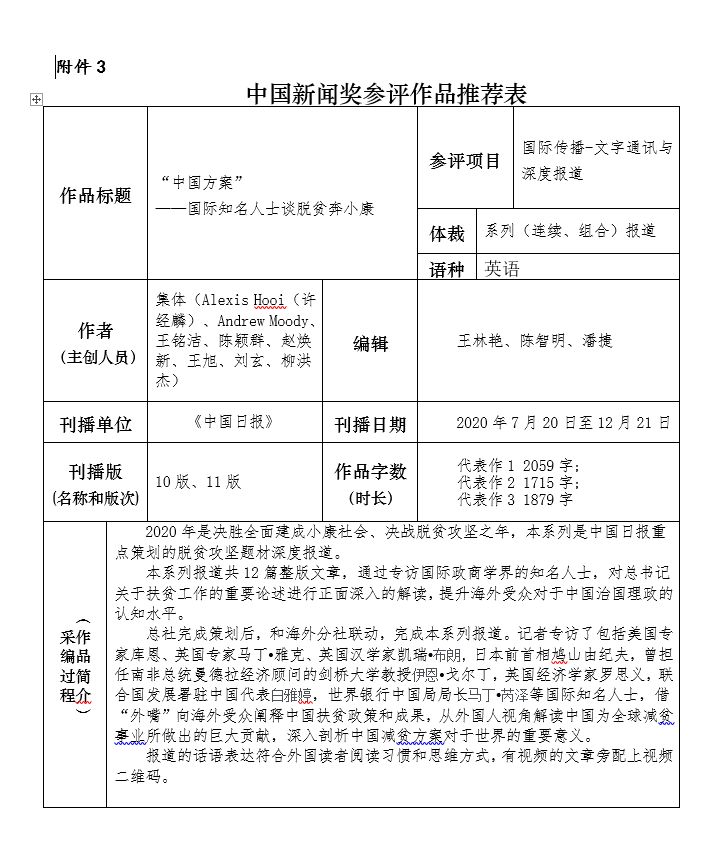
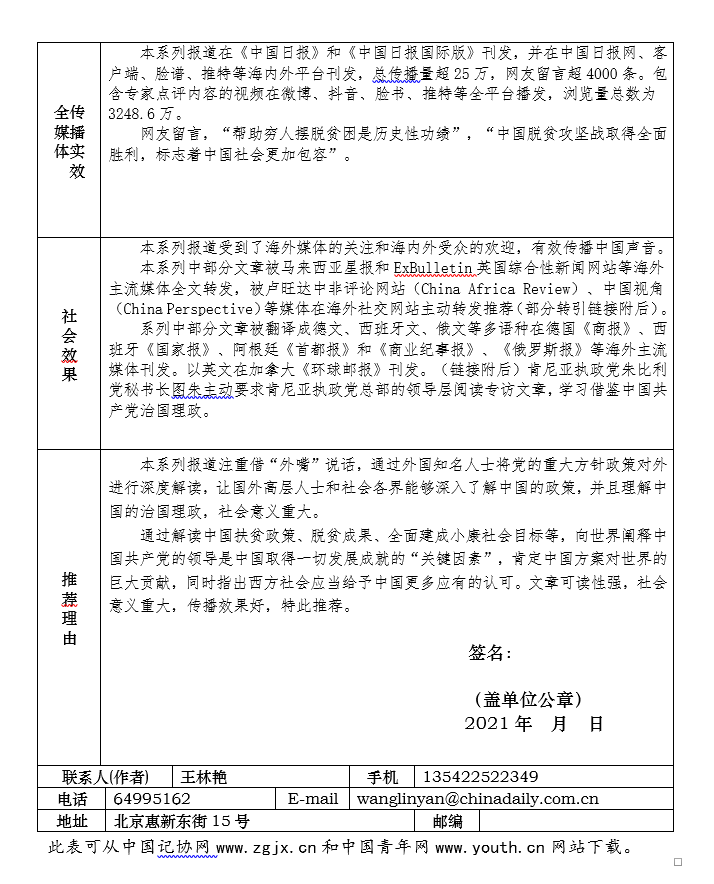
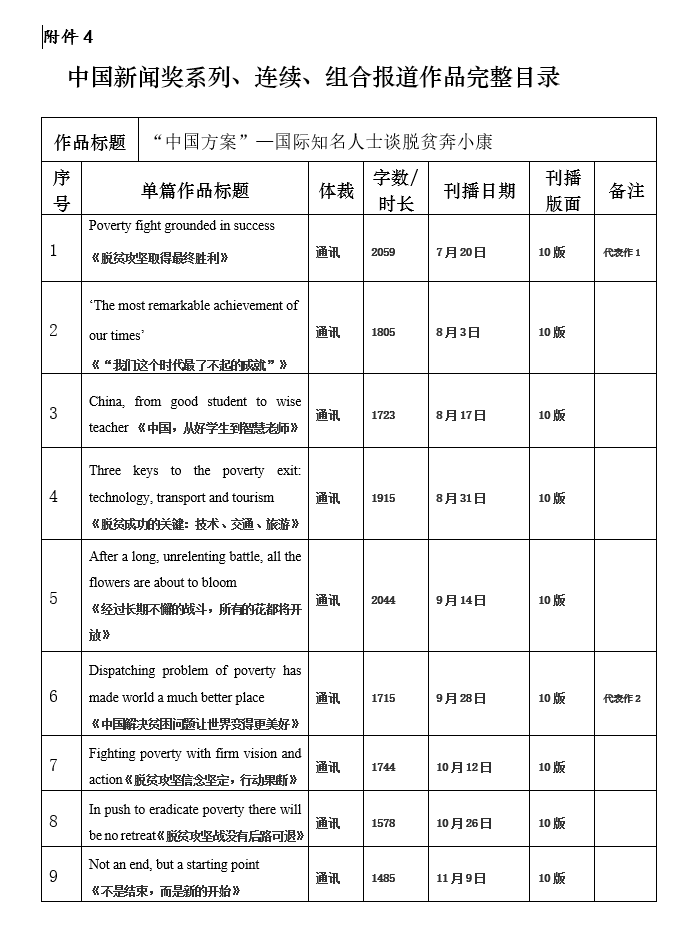
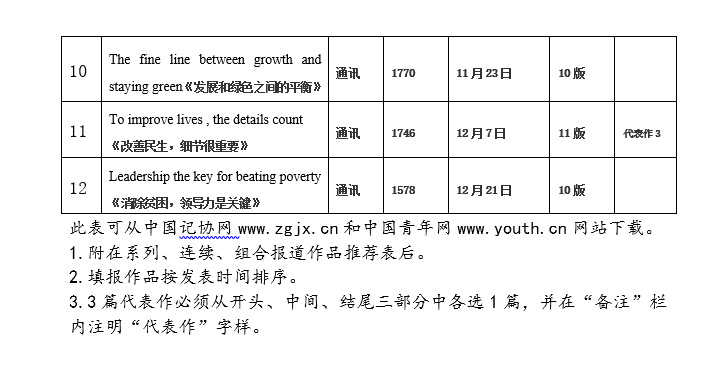
代表作1:
原文:
Poverty fight grounded in success
Renowned China expert lays out country's impressive efforts, grassroots focus in taking on monumental challenge
Editor's note:As China aims to eliminate extreme poverty and be a "moderately prosperous society" (xiaokang shehui) in time for the 100th anniversary of the founding of the Communist Party of China next year, we talk to leading experts for their take on the country's commitment.
By Alexis Hooi
Located in some of the poorest areas across the country, the communities are the focus of targeted, antipoverty measures suited to their specific conditions.
For renowned China expert Robert Lawrence Kuhn, there is actually an invaluable element that is common among the impoverished beneficiaries of the national drive to improve their lives.
"Every single poor family has its own customized file. It is a notebook. And each one has a page with all the family members listed. It has the plan that they are trying to achieve, the plan how they will get out of poverty," Kuhn said.
"Every month there is an entry about how they are doing. What are their problems? Every poor family in the country has someone responsible for them. The information is all taken and digitized and sent to Beijing. A central office compiles all that data."
"At the grassroots level, each village has one individual responsible for knowing every single poor family in that village-normally it is a young Party secretary assigned there. Each family has its own targeted plan," he said.
"That's what targeted poverty alleviation means. I had understood that. But when I actually saw the piles of books representing every family, in several different villages, it made a strong impression on me."
For more than three decades, Kuhn has worked with China's leaders and advised the Chinese government on the country's development. In December 2018, he was awarded the "China Reform Friendship Medal" by President Xi Jinping and Chinese leaders, on the 40th anniversary of China's historic reform and opening-up.
Kuhn has written over 30 books and his expertise is also widely presented through international media organizations. Most recently, in his major work communicating the story of China, Kuhn has been asked to focus on China's poverty alleviation campaign. It has been a monumental challenge that China has risen up to, he said.
"China's poverty alleviation campaign is one of the most remarkable stories of modern times in the broadest sense, not just for poverty alleviation itself, but also in terms of the advancement of human civilization. The story really needs to be appreciated more, certainly in the West, but also in China," Kuhn said.
In one of his latest projects, Kuhn is the host and writer of Voices from the Frontline: China's War on Poverty, the first in-depth documentary of its kind about China's poverty alleviation drive to be broadcast abroad, showcasing the country's strategies and structures in eradicating extreme poverty. The film was directed by Peter Getzels and executive produced by Adam Zhu.
Production took two years and the film crew visited poor households in six areas-Guizhou, Gansu, Shanxi, Sichuan and Hainan provinces and the Xinjiang Uygur autonomous region. Kuhn and his team interviewed government officials at the central, provincial, city, county, township and village levels, recording a large quantity of firsthand information.
Other than the targeted, customized plan of each family to lift them out of absolute poverty, Kuhn said another impressive aspect of the poverty alleviation effort was how the local officials are "dispatched to impoverished villages to manage poverty alleviation, often for two years. Moreover, Party officials at the front lines in fighting poverty cannot leave their current post and cannot be promoted unless and until they fulfill their specific, numeric, poverty-alleviation goals. We watched local officials being held accountable, their careers at stake".
"Those individuals were Party or government officials who were on their way up in their career. They were generally in their early 30s or late 20s even," he said.
"Some of these individuals had good, up-and-coming jobs in the provincial capital, or the major cities, working in government. And now they're working in the poorest areas.
"This was not like a career detour. They were on their optimum career path.
"Because in the Chinese system, that grassroots experience is exceedingly important. It will actually help their careers and help their promotion opportunities. When you build this type of motivational behavior into the system, the system itself sends the message to those people who want to advance their career that this is how you do it-this is the shortest path for your career advancement: work at the grassroots level, learn how poverty is being alleviated," Kuhn said.
"I met one official, for example; he had worked in a provincial capital, in water resources, as maybe a deputy division head. He went to this village where he focused on building a sewage and water system for that village of some 200 families or so, most of whom were poor. He took the task as a matter of not just a goal to achieve, but also as a matter of pride, that he was going to improve their lives and he was going to make this happen under his watch," he said.
"These assignments became a badge of honor and a mechanism for career advancement. As noted, these administrative behavioral structures motivate officials to work toward objectives set by the Chinese government. As such, to understand how it works in China may be helpful for other countries, other cultures, so they may discern how to adapt China's poverty alleviation system to their own conditions and cultures."
Kuhn said his experience on the ground "led to insights about how China's extraordinary poverty-alleviation program actually works".
"Although poverty is being fought the world over, there is nothing anywhere like China's relocation of whole villages on a massive, national scale-moving people from remote rural areas to cities and suburban areas, providing homes and jobs, giving them a real chance at a better life," he said.
Kuhn cited one trip to Huishui county in Guizhou province, where whole villages were being relocated from remote mountain hamlets to a new community 70 km away.
"I learned that housing is free for villagers who relocate here. A family of four receives up to 80 square meters of living space, 20 per person. The government also covers all basic amenities, including sofas, beds, kitchenware, and TVs," he said.
"But how can these rural men, who were farmers, learn new, non-farming jobs? I joined a cooking class and got to know one of the former farmers, who was learning to be a chef. I spent time with three generations of his family and several of his friends. Almost everyone was appreciative of their new lives," Kuhn said.
"But not everyone," Kuhn added; "that would be unrealistic. One recently relocated villager told me that the government misrepresented how much income he and his family would get, but it was too late to return to the village because their homes had been demolished as soon as they agreed to be relocated."
"Moreover, not everyone from the villages agrees to move to the new communities. After all, the farms have been their lives for generations. I traveled to Daijing village to meet the Party secretary. His job was to convince the few remaining villagers to relocate. It is policy that neither he nor the government can force people to relocate."
Kuhn stressed the importance of confronting corruption in poverty alleviation work.
"In such a massive country, with such large flows of funds, and with officials' careers on the line, there is risk of abuse and manipulation. While cheating and stealing in poverty alleviation are not unexpected, it is especially unseemly," he said.
"With career stakes high and funding vast, cheating and stealing are no surprise. Of the 122,100 cases of corruption in China in 2017, 48,700-more than one-third-related to poverty alleviation work," Kuhn said.
"I applaud the government in releasing these unflattering statistics! China will not allow falsifying data, or misappropriating funds, to undermine its poverty alleviation goals," he said.
Another impressive feature of poverty alleviation was the system put in place to stem fraud, called "third-party evaluation", Kuhn said.
"The governing idea is that since the independent evaluators would be coming from completely different regions, they would not likely know any of the officials whom they would be evaluating and thus not be swayed by personal relationships.
"The task is to evaluate both the successes and the challenges of the poverty alleviation process-and to assess how officials were doing their jobs," he said.
"To ensure that the local officials do not prepare for inspection visits, the evaluation team decides where they will go only at the last minute, often the same morning of the inspection.
"When officials are pressured to meet their firm objectives in a compressed period of time, some may cut corners or fudge numbers," Kuhn said.
"I commend the State Council Leading Group Office of Poverty Alleviation and Development for its independent checking and inspecting, avowing that if there is any false reports or fraud, officials will be held accountable and dealt with seriously, so that the results of poverty alleviation can stand the test of history and the people. The greater the transparency of government, the greater the confidence in government," he said.
"Between 2015 and 2019, all across China, almost 3 million Party officials were working on the front lines of rural poverty alleviation (that's cumulative-some 750,000 at any given time). Officials know that their careers prosper or falter based on their poverty-alleviation results."
The feats achieved so far in China's fight against poverty are essential steps toward fulfilling the country's stated aim to be a "moderately prosperous society" in time for the 100th anniversary of the founding of the Communist Party of China next year, Kuhn said.
"After all, how could China claim to be a moderately prosperous society if any of its citizens continued to live in absolute, extreme or abject poverty? No matter how large China's GDP, no matter how large China's income per capita, China could not claim to have achieved this goal unless and until every citizen was living above the line of absolute poverty," he said.
"Today, in the Western world, especially in the US, there is concern about China's actions and suspicion of China's motives. While all political systems have trade-offs, poverty alleviation, to me, is the best disrupter of such stereotypes," he said.
China was on track to meet its target of eradicating extreme poverty in rural areas and eliminating regional poverty by 2020 when the COVID-19 epidemic struck and some may question whether it can still achieve its goal, Kuhn said.
"During an inspection tour in Northwest China's Shaanxi province, President Xi urged enhanced efforts to overcome the negative impact of the COVID-19 epidemic and ensure that the country does achieve its original poverty-alleviation goals in 2020," he said.
Again, Kuhn's latest work on the ground helped him to experience "firsthand the impact of President Xi's remarkable statement: 'I have spent more energy on poverty alleviation than on anything else.'"
Still, China's targeted poverty alleviation drive faced or faces at least four challenges, Kuhn said.
"First, is the data reliable? There is an obvious conflict if the same officials who do the poverty alleviation remediation work also do the poverty alleviation assessment work. As noted, I've seen independent auditors, often unannounced, checking and spot-checking-but I still hear talk that some data is suspect, because local officials are under such great pressure. That's why central authorities have become even more committed to independent checks, punishing officials convicted of fraud," he said.
"Second, there is natural conflict between officials who want to bring people out of poverty, in order to benefit their careers, and village people who want to remain classified as poor, in order to maximize their subsidies. These are normal human motivations and individual cases often test the wisdom of officials.
"Third, what's to prevent those who are pushed just over the line of extreme poverty, after the excitement dies down, after 2020, from falling back down below it? For China's poverty reduction to be counted a true success, it must be sustainable," Kuhn said.
"Fourth, living barely over the line of extreme poverty, far below standards of living enjoyed by China's urban middle class, hardly makes for a society of common prosperity, China's long-term goal. The fight against poverty cannot end in 2020," he said.
"To truly eliminate all poverty in China, and to do it sustainably, poverty alleviation programs must continue to be an ongoing process and an ongoing priority in China. It is, indeed, a Long March."
代表作2:
原文:
Dispatching problem of poverty has made world a much better placeSuccess of eradication drive lauded as an extraordinary achievement
Editor's note: As China aims to eliminate extreme poverty and be a "moderately prosperous society" (xiaokang shehui) in time for the 100th anniversary of the founding of the Communist Party of China next year, we talk to leading experts for their take on the country's commitment.
By Andrew Moody
Ian Goldin insists that without China achieving a moderately prosperous society the world would be a lot poorer.
The professor of globalization and development at Oxford University said important targets such as the United Nations Sustainable Development Goals would be missed and people across the globe, not just in China, would be in a much worse place.
"When you look at the global statistics of poverty reduction, much of what has been achieved has been driven by China," he said.
Goldin, a former economic adviser to the late South African president Nelson Mandela, says the scale of China's achievement in delivering 850 million out of poverty in a little more than 40 years is not widely acknowledged in the West. The world's second-largest economy is set to achieve xiaokang and become a moderately prosperous society in time for the 100th anniversary of the Communist Party of China next year.
"It is the most rapid poverty reduction by far of any country ever in history," he said. "It is an extraordinary achievement. When you look at the global statistics of poverty, a large part of the progress globally is driven by China. If it had not been for China we'd be far off target in achieving all the UN goals."
Goldin, speaking from Oxford during the UK coronavirus lockdown, looks in his latest book Terra Incognita: 100 Maps to Survive the Next 100 Years at the important role China has played in global efforts to reduce poverty.
China is right to give priority to eliminating extreme poverty in its own country by the end of this year, he said that poverty is still a massive problem worldwide.
The 65-year-old South African points to World Bank figures showing that 2 billion people live in poverty globally, and in 2015 about 736 million were in extreme poverty, on less than $1.90 a day.
Massive issue
"It is a massive issue. Poverty is widespread and it is perhaps the most significant global issue of our age."
The coronavirus pandemic could result in many more people being pushed into poverty because many developing countries have weak health systems and nonexistent social safety nets, he said. A World Bank report in June forecast that up to 100 million more people could be pushed into extreme poverty.
"The pandemic is going to greatly exacerbate an already bad situation. It is going to throw hundreds of millions of people back into poverty and many into extreme poverty and starvation."
For Goldin, this does not come as a surprise, given that he forecast a pandemic in his 2014 book The Butterfly Defect: How Globalization Creates Systemic Risks, and What to Do about It.
"This has been a disaster waiting to happen for a long time. It was merely a question of where and when it would start."
Goldin, who is a frequent visitor to China and a regular speaker at the China Development Forum, an event held in Beijing each spring, and which attracts experts and thinkers from around the world, is impressed by President Xi Jinping's ideas on poverty.
Xi, in fact, has made poverty eradication a mission since he was Party chief of Ningde city in Fujian province in the late 1980s. In his book Up and Out of Poverty he sets out four important principles for tackling it: avoiding a poverty mentality (if you believe you are poor, you will be); adopting development measures appropriate to local conditions; strong leadership and coordination; and not wasting money on grandiose projects just because they may be popular.
"These are all very important but he is right to stress avoiding a poverty mentality," Goldin said.
"If you believe you are simply condemned to be poor by virtue of your birth and your circumstances, you will not strive to escape.
"Neither government nor society will feel it is their responsibility to act if they think that some people are just destined to be poor. They will not see it as their absolute responsibility to eliminate that."
Goldin also said Xi is right to emphasize that poverty alleviation strategies need to be aligned to local conditions, which Western policy makers have often disregarded at huge cost.
"There has been this cookie-cutter view of it in the West where a particular development model was dreamed up in Washington or by colonial rulers and it was to be applied everywhere. It proved a disaster.
"Africa is littered with the carcasses of development projects which at some point were regarded as a panacea."
Goldin said good governance and coordination as has been demonstrated by Xi and others in China is vital to alleviating poverty.
"Coordination is certainly vital. There is no point in building a school if you don't have teachers for it, or a hospital if you don't have nurses, doctors or equipment.
"You need coordination across the country too. You can't have provinces which are extremely wealthy because they are easy to access from the capital, and others which are more remote and find they are left behind because no one comes and opens projects there."
Goldin, who studied at the University of Cape Town and also has a degree from the London School of Economics and a doctorate from Oxford University, has had a high-profile career as a professional economist and academic. He has also served on the boards of a number of leading international companies, including Old Mutual, the Pan-African investment and banking institution.
Sustainable development
He came to prominence as principal economist at the European Bank for Reconstruction and Development and as program director at the OECD Development Centre in Paris, where he was engaged on sustainable development.
In 1996, he became chief executive and managing director of the Development Bank of Southern Africa, and it was in his five years there that he worked for Mandela. He was also director of development policy at the World Bank from 2001 to 2003 and then its vice president from 2003 to 2006.
He is best known at Oxford as founding director between 2006 and 2016 of the Oxford Martin School, which brought together the university's expertise in critical global challenges, including climate change and development issues.
Apart from The Butterfly Effect and his latest work, Goldin has written a number of influential books, including Exceptional People: How Migration Shaped Our World and Will Define Our Future and, with Chris Kutarna, Age of Discovery: Navigating the Risks and Rewards of Our New Renaissance, which present an optimistic view of the world's development.
Goldin said the current pandemic has the potential to halt global progress and that there needs to be concerted action on the scale of a new Marshall Plan to ensure that developing nations, in particular, do not suffer too much from the crisis.
"What we need is a massive global response from the G20, the G7, the World Bank and other institutions.
"What we have is a very tepid and fragmented reaction, and that's partly, of course, because of the US not providing any leadership role. It is not only the US. Other countries have not stepped up to the scale of this challenge."
Positive outcomes
Goldin hopes one of the more positive outcomes of the pandemic will be the rejection of nationalism and protectionism and an acceptance that globalization is the only solution to the world's problems.
"Globalization is absolutely essential. Without it there will be no progress in the world, there will be no poverty reduction, there will be no vaccines to stop pandemics, there will be no coordination to stop climate change or antibiotic resistance or other threats we face.
"There will be no sharing of technologies, or investment of market opportunities to help people escape poverty."
Globalization has played a major part in China achieving xiaokang and eliminating extreme poverty, he said.
"China's progress has been absolutely associated with its opening up, and it has been a big beneficiary of globalization, but it's also been a contributor to it.
"China in many senses has sustained the global economy, and it's been the strongest locomotive by far to the global economy since the financial crisis, and probably will be after this one."
With his background in development issues in Africa, Goldin is aware of the extent to which African countries look to China as a role model in the way it has become a moderately prosperous society and tackled poverty.
China has forged strong links with Africa in recent years through the Forum on China-Africa Cooperation as well as major investment in and trade with the continent.
"What Africans see in China is a multidimensional strategy to reduce poverty which focuses on industrialization, urbanization, rural development and priority given to child development and education.
"It is this comprehensive strategy that they would like to emulate. The question though has to be whether they have the government capacity and financial capability to achieve what China has achieved."
While China has demonstrated not just to African but other developing countries is that the journey is possible, he said.
"China has shown that an extremely poor country can become an upper-middle income country over a relatively short period of time and with very little external assistance."
Goldin said that although China is about to eliminate extreme poverty, poverty levels are rising in a number of developed countries.
"You see the queues for food banks in the US, where there are now people in dire poverty. You have increased homelessness with people living on the streets.
"Rich countries too don't have adequate social safety nets, and people face extreme hardship. This is a world of rising inequality where a handful of billionaires have the same amount of wealth as half of the world's population."
Goldin rejects any notion that China has become rich on the back of countries such as the US, as some prominent politicians now argue.
"The reality is that the US economy is much stronger and has much higher levels of employment and growth because China is stronger and has higher growth.
"The US, in fact, would not be what it is today if China was still where it was in the late 1970s before it opened up. The idea that somehow China's success has been at the expense of the US is a complete misunderstanding as to how all this works. It is not a zero-sum game."
代表作3:
原文:
To improve lives, the details count
China's targeted anti-poverty strategy can help policymakers elsewhere, World Bank official says
Editor's note: As China aims to eliminate extreme poverty and be a "moderately prosperous society" (xiaokang shehui) in time for the 100th anniversary of the founding of the Communist Party of China next year, we talk to experts for their take on the country's commitment.
By Zhao Huanxin in Washington
China's reform and opening-up and its targeted interventions in reducing poverty are among the lessons that can be learned and disseminated among developing countries, which would also benefit from Beijing's new growth pattern that centers on an increased domestic market, the World Bank's China chief, Martin Raiser, says.
"Many lessons can be learned from China's sustained gains in poverty-reduction over the past 40 years," said Raiser, country director for China and Mongolia for the bank, a 189-member lender that gives priority to ending extreme poverty and promoting common prosperity.
Among the high-level lessons, Raiser highlighted the country's starting of its reform and opening-up four decades ago, which enabled it to reap "huge gains" in efficiency that drove an increase in incomes for all Chinese.
"The second lesson is that while reforms and allowing market forces to play a growing role in the economy were a big part of China's success, more targeted interventions became necessary, focusing in particular on the concentration of poverty in rural areas," Raiser said.
Raiser joined the World Bank in 2003 and was posted to Beijing in March last year. He was well aware of how China's massive poverty-relief drive had proceeded before his posting.
One of the "big things" that happened in the early 2000s was that China started building up a database of up to 150,000 villages, determined to be poverty-stricken places, and then policy was directed to help those particular areas, he said.
"Over time it became increasingly clear that poverty is no longer a place-related affliction, but it has a lot to do with personal household characteristics, and so from monitoring places you have to move to monitoring households," he told China Central Television on Oct 27.
"I think China clearly demonstrates that economic growth, and in particular the kind of economic growth that China was able to generate, is the key contributor to poverty-reduction in the first three decades."
Then over the past decade and particularly after 2013, the targeted social policies covered "the last mile" of the poverty-alleviation course, he said.
Initial concept
Targeted poverty-alleviation, a concept first raised by Chinese President Xi Jinping in 2013 during a visit to a village in Hunan province, was adopted as a strategy by the government in 2014 to "ensure that assistance reaches poverty-stricken villages and households".
The policy, which requires tailoring relief measures to different local conditions, was included in the first-ever resolution addressing poverty-eradication in rural areas, adopted by the United Nations General Assembly in 2018.
Between 2012 and 2019, China lifted at least 93 million rural residents out of poverty, or more than 10 million people annually, seven years in a row, according to official figures.
The proportion of poverty in rural regions had shrunk from 10.2 percent to 0.6 percent in the period.
But to better understand targeted interventions and assess the efficiency of the substantial rise in public spending in this area over the past decade, detailed microeconomic and fiscal data or case-study analysis is required, Raiser said.
"Clearly this will remain an issue of keen interest for development specialists, and we hope China will collaborate proactively with international researchers to ensure these lessons are learned and disseminated."
As China and the World Bank Group, or WBG, celebrate the 40th anniversary of their partnership this year, Raiser noted that exchanging knowledge rather than financing has become increasingly important to the relationship.
"In addition to us engaging with China's policymakers on critical policy choices, such as in the context of the upcoming 14th FYP(Five-Year Plan for 2021-25), this also includes the WBG learning from China's own development experiences and partnering with China to share this with other developing countries."
While in the past, many less-developed countries benefited from China's rapid, investment-driven growth as commodity exporters, such a growth model is running out of steam in China, which will need to rely more on domestic consumption to sustain growth, Raiser said.
"Such a shift could also create important opportunities for poor countries who could export labor-intensive goods and services to China, as China itself moves up the value chain."
For that to happen, China should combine macroeconomic policies to rebalance the economy with policies to further open up its domestic markets to competition, he said. "Whether it does matters for global poverty-reduction."
Zeng Peiyan, former vice-premier and chairman of the China Center for International Economic Exchanges, said at the 6th Global Think Tank Summit in Beijing in September that China has worked out a new economic-growth model of "dual circulation" for the next five years, focusing on its huge domestic consumer market and promoting high-level opening-up.
New development pattern
The new development pattern will by no means be closed domestic circulation. Instead, it is open dual circulation involving both domestic and foreign markets, President Xi said in a speech expounding on the country's new national development plan, Xinhua reported on Nov 3.
Xi also said that this year China's gross domestic product is expected to exceed 100 trillion yuan ($14.9 trillion), people's living standards will significantly improve and all rural impoverished populations will be lifted out of poverty by current standards.
In addition, the goal to complete the building of a moderately prosperous society in all respects can be achieved on time, Xi said.
Raiser said that once extreme poverty has been eradicated, countries need to address social vulnerabilities.
Rebalancing toward consumption is one way for the government to help with the vulnerable population, he said.
During the COVID-19 crisis, for instance, some migrant workers and others informally employed in China's urban areas became vulnerable, as they had not been previously featured as target populations for the government's poverty-eradication programs.
"Social policies thus needed to be adjusted to cover these groups," he said.
Raiser, in an interview with China Daily, on Oct 12, said the government can help "the living standards of those at the bottom of the distribution" through better targeted assistance, a stronger social insurance system and a stronger social transfer system.
"China has the fiscal space to do that," he said, adding that it will require a little more government spending, but will have the benefit of supporting the rebalancing toward consumption.
One of the reasons people in China save a lot is because they feel if something happens to them they have to rely on themselves, Raiser said.
"If they knew that the government is going to provide a bit more assistance, they would probably feel that they can afford to spend a bit more. And that would be good for the Chinese economy, and for the rebalancing."
Another way to help the disadvantaged is to make sure that economic growth is inclusive, he said. "That means that jobs are created, and that the wages of people at the bottom of the distribution continue to increase."
Raiser has closely followed development for China's 14th Five-Year Plan, which is expected to be endorsed by the country's top legislature next year.
In a blog posted on the Brookings Institution website on Nov 10, Raiser and Marcin Piatkowski, a senior economist at the World Bank, said the plan is likely to emphasize investments in digitalization, which will have consequences for social and economic outcomes.
"There is emerging evidence that the development of e-commerce is associated with higher employment, faster growth in incomes, increased entrepreneurship, reduced migration outflows, higher gender equity and reduced poverty," they wrote in "China 4.0: Sharing the dividends of digitalization".
In fact, China has ramped up efforts to expand internet-based services to the vast rural market by improving infrastructure, especially in poverty-stricken areas.
Fiber-optic availability in the country's poor villages has reached a record 98 percent, and a rural e-commerce promotion project has covered all the 832 poor counties, Yang Xiaowei, deputy head of the Cyberspace Administration of China, said at a news conference on Nov 6.
As the world wrestles with a pandemic that has killed more than 1.53 million people, Raiser said how China recovers from the pandemic "matters significantly" for a lot of the country's trading partners.
China continues to be the only major economy to grow this year, when global contraction of 4.4 percent is expected, according to the World Economic Outlook that the International Monetary Fund issued in early October.
'A rapid return'
China's GDP grew 4.9 percent year-on-year in the third quarter, compared with growth of 3.2 percent between April and June, suggesting "a rapid return to the pre-COVID trend", according to US economist Stephen Roach, former chairman of Morgan Stanley Asia.
"In this sense, the fact that China seems on track to record positive growth this year is obviously welcome," Raiser said.
However, as the rest of the world recovers, one would expect China's trade surplus to shrink, he said.
World Bank President David Malpass warned recently that the coronavirus may have driven as many as 100 million people back into extreme poverty and that "that number could go higher" if the pandemic worsens or drags on.
The pandemic will reverse the progress made since the 1990s in reducing global poverty and will increase inequality, the IMF said in its outlook.
People who rely on daily wage labor and are outside the formal safety net faced sudden income losses when mobility restrictions were imposed. Among them, migrant workers who live far from home had even less recourse to traditional support networks, the outlook said.
The World Bank's chief economist Carmen Reinhart said the global economy may take up to five years to recover from the crisis caused by the pandemic.
In April, the World Bank and the G20 finance ministers endorsed the Debt Service Suspension Initiative, or DSSI, in response to a call by the World Bank and the IMF to grant debt-service suspension to the poorest countries to help them manage the severe impact of the COVID-19 pandemic.
"China is a member of the G20 and as such participates in the DSSI initiative," Raiser said. "This is very important, because China is an important creditor to many of the poorest countries."
The United States, China and other G20 countries on Nov 13 agreed for the first time on a common approach for restructuring government debt as the coronavirus crisis leaves some poorer countries at risk of default, Reuters reported.
In a video speech delivered at a UN General Assembly session in late September, President Xi said China will honor its commitment to provide $2 billion in international assistance over two years, further international collaboration in fields including agriculture, poverty-reduction and climate change, and support other countries in restoring economic and social development.
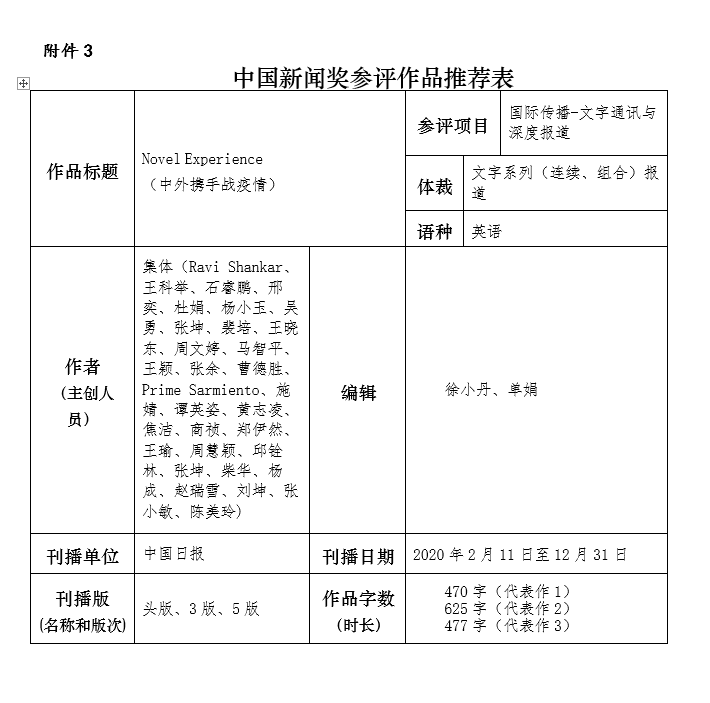
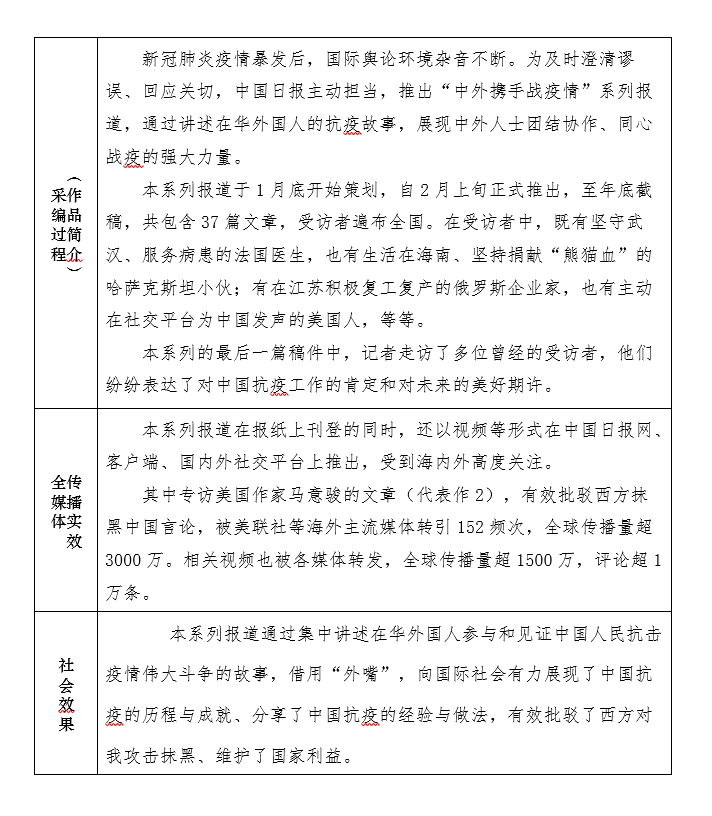
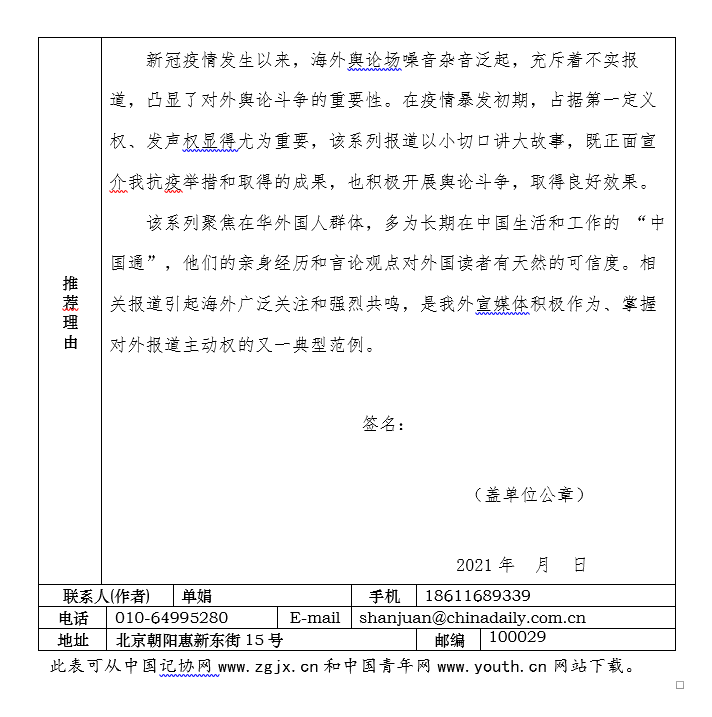
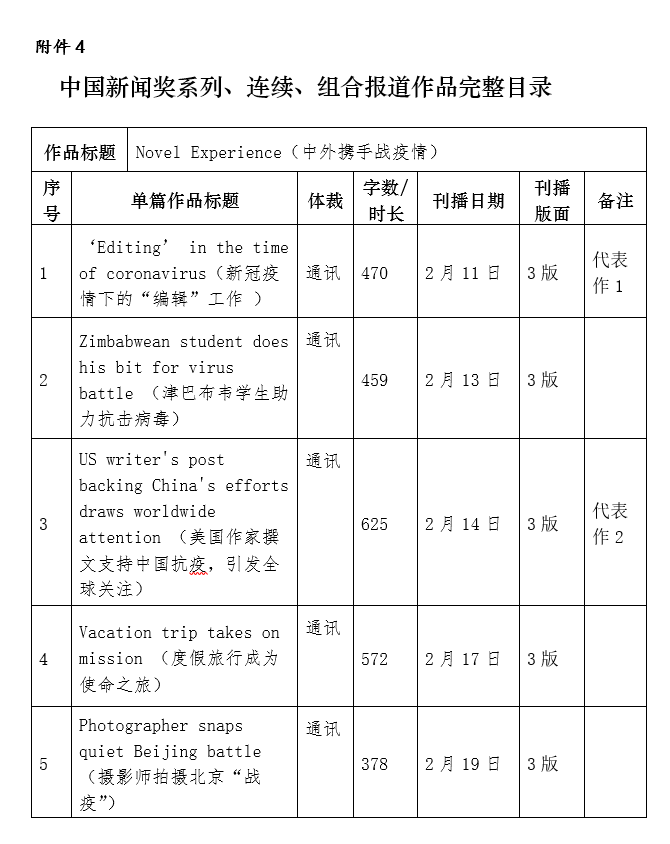
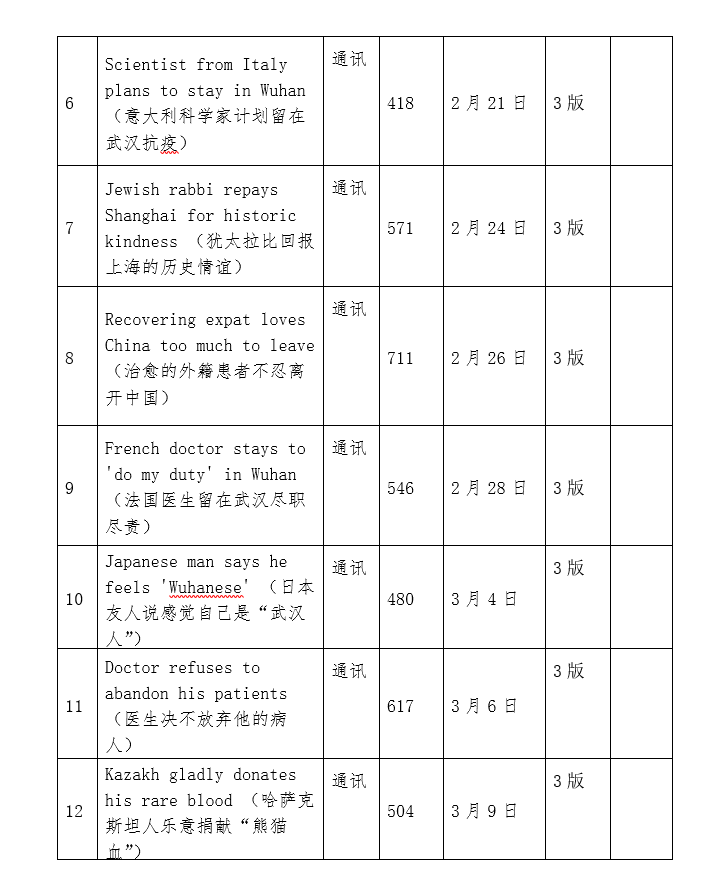
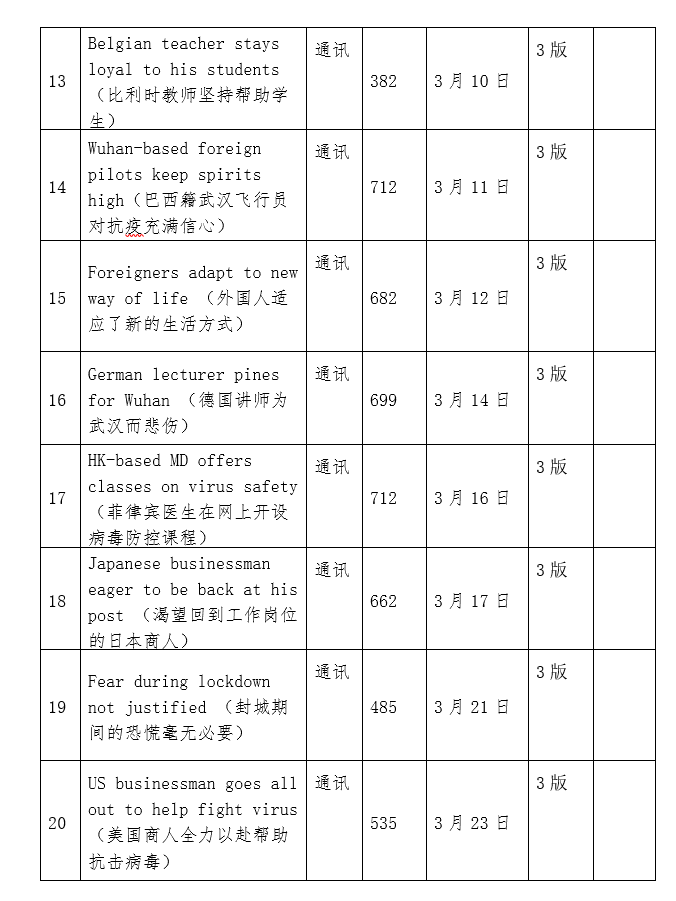

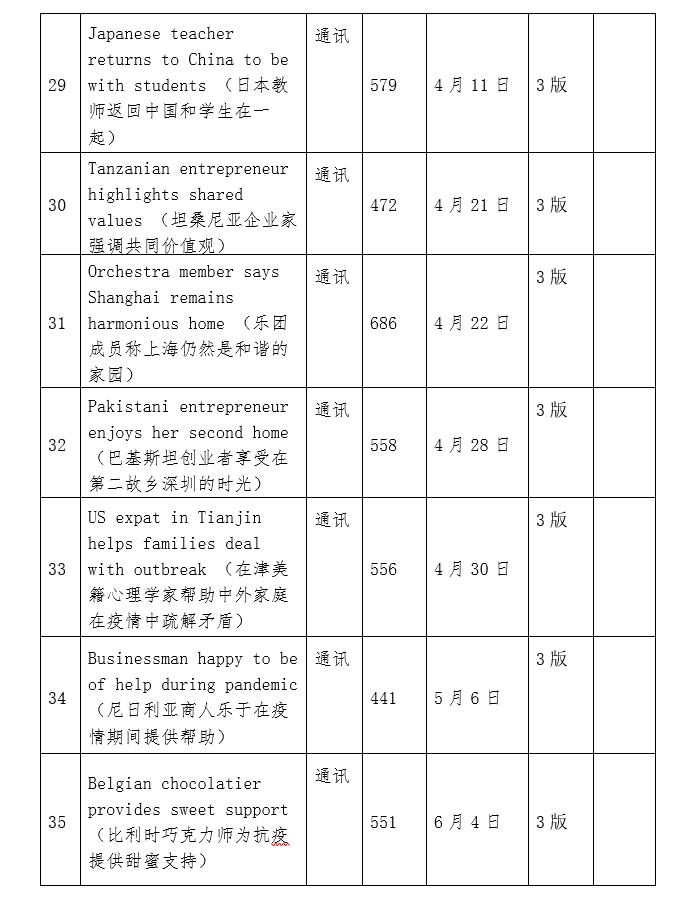
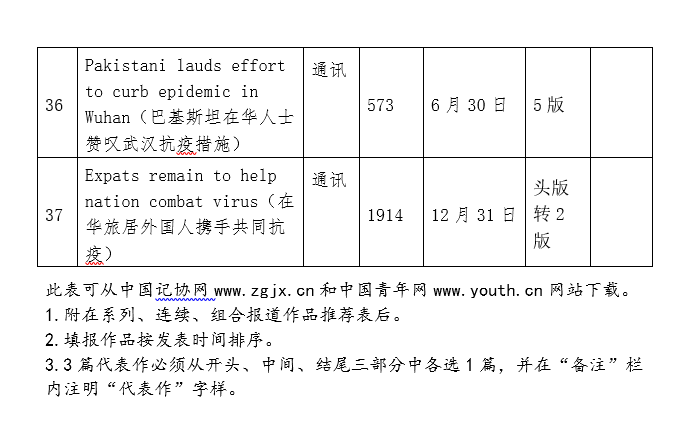
代表作1:
原文:
'Editing' in the time of coronavirus
By RAVI SHANKAR in Hyderabad, India
I have become a fact checker for messages asking my opinionmost of them fake news, and some so gruesome that they should have come with warnings.Editor's note: In this new column starting today, we'd like to share stories and experiences of expats on how they are dealing with the novel coronavirus pneumonia outbreak.
In home quarantine now, having arrived in India just before Spring Festival and subject to the 28-day mandatory period, my job as a China Daily editor continues-albeit in ways I never envisaged before.
However, other messages include glowing tributes to the doctors, nurses and other medical staff at the front line in what has been described as a "war".
Ever since late January, Indians have watched in anguish and awe as China pulled out all stops to battle the deadly novel coronavirus pneumonia raging in Central China.
Anguish was about the fate of hundreds of students and corporate staff in Wuhan, Hubei province, as depressing news about NCP spread.
This was soon relieved as two Indian planes evacuated more than 600 people from the epicenter of the outbreak.
Indian officials, including Prime Minister Narendra Modi, have been effusive in their praise for Chinese officials who helped facilitate the evacuation.
Modi expressed solidarity with President Xi Jinping and the people of China over the outbreak of NCP, and offered condolences at the loss of lives, Indian media reported on Sunday.
Awe was in the form of photographs being widely circulated of the two hospitals built in a matter of days in Wuhan. Many Indians, so used to hearing about "China speed "and admiring and envious of the country's infrastructure, could only mutter, "Only in China".
There is also great sympathy for people forced to stay home as videos of empty streets and public transport facilities do the rounds.
Along with commiseration, there was consternation and confusion, too, among Indian businesses with extensive links to China.
One friend, who visits Guangdong almost every month, recently started a home-automation business with equipment sourced from the province. He is not sure when his next shipment will come.
Another, who imports hundreds of thousands of TV set-top boxes, also from Guangdong, is worried about the supply chain.
More critically, supplies of drug ingredients for Indian pharmaceutical manufacturers, mostly antibiotics and vitamin makers, are likely to be disrupted, Indian media reported.
Indian drug manufacturers are to a large extent dependent on China for sourcing their drug ingredients, or active pharmaceutical ingredients, mainly for antibiotics and vitamins. They are based on drug ingredients made using the fermentation-based process, an area where China has global dominance.
Amidst all this, was the uplifting story widely reported in Indian media of a wedding between Wang Jihao from Beijing and Satyarth Mishra in the central Indian town of Mandsaur, 4,500 km from her home, on Feb 2. They met in Beijing, where he was studying. The couple were in India before the virus outbreak.
Meanwhile, I continue my "editing" at home.
代表作2:
原文:
US writer's post backing China's efforts draws global attention
By XING YI
Author Mario Cavolo of the United States might be known for his books about China, but it is one of his LinkedIn posts that has gone viral on the internet.
Based in Shenyang, Liaoning province, the Italian American writer had on Feb 5 written a commentary on the social networking site about the global reactions to China during the ongoing novel coronavirus pneumonia outbreak.
The article, titled Something's Not Right Here Folks, delves into the overreaction of some Western governments, the discrimination against Chinese people and Western media coverage that discredits the Chinese government's efforts in controlling the epidemic. Cavolo also compares China's response to the novel coronavirus epidemic with the 2009 H1N1 pandemic in the United States, and highlights the contrasting reactions to the two health crises.
An excerpt of his article, which has since been viewed more than a million times, reads, "During 2009 H1N1 outbreak, I don't recall xenophobic anti-America attacks across the globe, do you? Do you recall it took six months for the United States to declare a national emergency? Did any government from the onset in April 2009 through the end in April 2010, including the month of June, when H1N1 was declared an international emergency global pandemic, then send out a notice to its citizens that they should leave the US? Close their borders to American travelers? Nope, not a peep."
In an interview with China Daily on Wednesday, Cavolo explained what compelled him to write the post.
"Every country is great, and every country has problems, but when we read major headlines in the West, we find these negative slams, these negative biases. ... I felt tired of it, so I wrote the article, "he said. "Surely enough, I struck a nerve in the hearts of people."
Cavolo said that the majority of the comments on his post have been "super supportive", noting that many people agree with him.
Maria Vesterlund, a former General Electric senior supply chain manager who is based in Shanghai, is among those who share the sentiment.
"We moved to Shanghai last year in August and now sadly face the same media pollution of gossips and panic information spread. ... I hear friends telling me they don't go to the local Chinese restaurants in Munich or Frankfurt-afraid of the coronavirus," she wrote in her comment on Cavolo's post.
"We stay here and do not run away. ... We feel with the people here, locals and expats who suffer the consequences, closing their shops, missing their incomes for living, staying home for weeks, not meeting friends, missing all the joy of life-to support the stop of spread around."
Born in Yonkers, New York, Cavolo moved to China in 1999 and worked as a consultant for various companies before starting his own business in public relations. He has written two books on China's economic boom and lived in several cities across the country, including Chengdu in Sichuan province, Hangzhou in Zhejiang province and Shanghai. He currently resides in Shenyang, his wife's hometown.
While Cavolo noted that China's management of the SARS epidemic in 2003 was not ideal, he pointed out that the authorities have learned from past experience and have responded better to the current crisis.
"Chinese media have been talking more and more about problems happening in the society, and problems of the government are discussed on the news," he added. "Such things are not being suppressed, which was what the West accuses China of. Such accusations are not sensible and have to stop."
Cavolo said that it is important for people to empathize with the Chinese at this point in time and to seek to uplift their spirits as they work to combat the virus. He also expressed confidence that the epidemic will pass by the time spring arrives.
"I think I will play the piano and do a victory concert in spring," he said. "There will be victory concerts all over the country, and we will have a great time and things will be even better than people expect. Wuhan, stay strong! China, stay strong!" he said.
代表作3:
原文:
Russian impressed by action on virus
By CANG WEI in Nanjing
Andrey Kravchenko, a Russian who has been living in China for nine years, said that the country impressed him greatly with the strong action taken to protect its people and help prevent the virus from spreading during the coronavirus outbreak.
Kravchenko, a former vice-mayor of the Russian city of Stavropol and former vice-president of Energomera Group, has been living in Changzhou, Jiangsu province, with his family since 2011. He said that the city is his second hometown.
Kravchenko now works as the general manager of Monocrystal, a photovoltaic technology company.
During the novel coronavirus outbreak, he offered advice on the resumption of production to the local government and donated 100,000 yuan ($14,270) to the Changzhou Red Cross.
To help employees during the COVID-19 outbreak, the company offered them interest-free loans of 200,000 yuan and paid their salaries in advance. An additional subsidy was also allocated to employees who were on duty during the outbreak.
Monocrystal resumed production on Feb 10, and it was among the first companies in the city to do so after the start of the outbreak. The company provided its employees a large amount of disinfectant, goggles and masks to help protect them during the outbreak.
It also maintained close contact with suppliers and ensured that sufficient materials could be transported in time to guarantee production.
"I believe that China contained the coronavirus in relatively a short time, which helped prevent the virus from spreading," said Kravchenko.
"I also believe that China frankly reported to the world the epidemic situation within the country and has shared its experience to help other countries fight the virus."
Kravchenko said that China's fight against the virus impressed him greatly and gave him a better understanding of the country and the Chinese people.
"China is not what it was 10 years ago," he said. "We had many difficulties in establishing the company in China, which has a different language and different laws. I've received help from many people before and during the outbreak of the coronavirus.
"Now our life has become normal after the coronavirus was contained effectively in the country, but the virus made me realize deeply that life is short and I should try my best to help others."
Kravchenko made a video to encourage the Chinese people when the coronavirus outbreak was at its peak in the nation, in which he said that the key to winning the battle was to maintain order, patience and personal hygiene.
"If we stand united we can overcome the difficulties," he added.
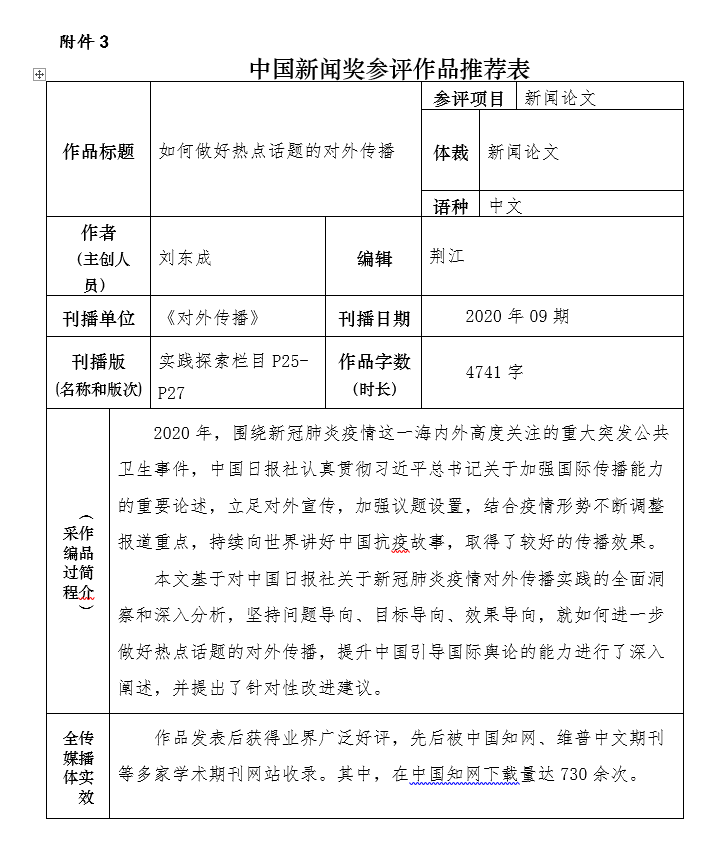
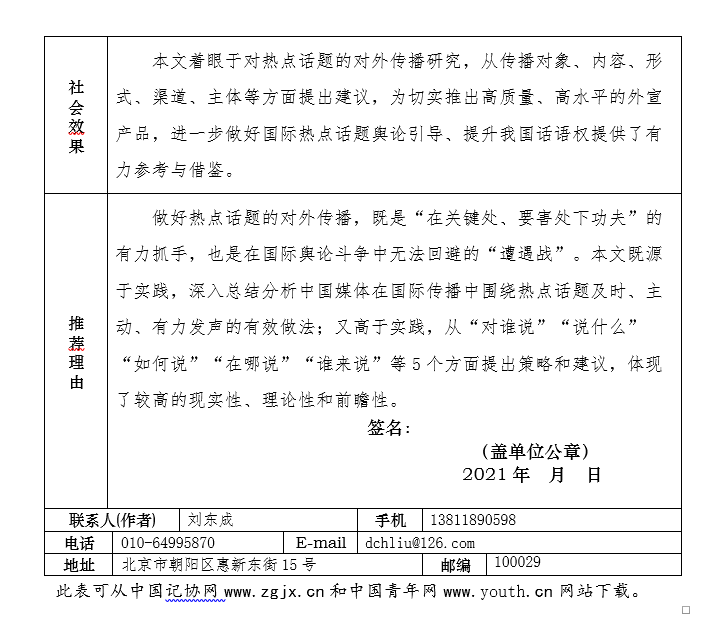
原文:
如何做好热点话题的对外传播
——以中国日报社关于新冠肺炎疫情的对外传播实践为例
新时代的中国日益走近世界舞台中央,为人类作出了更大贡献,受到国际社会越来越多关注。围绕热点话题,强化对外传播,主动回应受众关切,及时澄清谬误,在加强“自塑”中减少“他塑”,在主动减少“落差”中有力消除“反差”,对讲好中国故事、传播好中国声音具有重要的现实意义。本文以中国日报社关于新冠肺炎疫情的对外传播实践为研究对象,探讨如何做好热点话题的对外传播。
2020年初,新冠肺炎疫情暴发,这是新中国成立以来发生的传播速度最快、感染范围最广、防控难度最大的重大突发公共卫生事件。[①]海内外高度关注,疫情舆情相互交织并随着时间推移和形势发展不断演变。为增进国际社会对中国疫情防控举措与成效的认知、认可与认同,中国日报社立足自身特色优势,积极向世界讲好中国抗疫故事,助力全球携手抗疫,推动构建人类卫生健康共同体。
一、以核心报道为引领,及时报道疫情防控的中国举措、中国担当
围绕国际社会对中国疫情防控举措的高度关注与持续关切,中国日报社以2017年建立并不断完善的核心报道机制为抓手,统筹报网端微全平台,加强策划,深入报道在习近平总书记亲自指挥、亲自部署下,中国及时、有效打响疫情防控阻击战,有力维护人民生命安全和身体健康,为维护地区和世界公共卫生安全作出的重要贡献。
1.全面报道习近平总书记亲自指挥、亲自部署,带领人民坚决打赢疫情防控阻击战。报纸头版、网站首页、客户端首屏、“学习时代”专栏等重要位置持续刊发《亲自部署!习近平:坚决打赢疫情防控阻击战》《习近平战“疫”高频词》等融媒产品,解读报道习近平总书记主持召开中央政治局常委会会议等系列会议、赴多地考察全面部署做好疫情防控工作情况。其中,社论《精准施策,加快推动经济社会发展》,解读习近平总书记赴湖北考察疫情防控工作时重要讲话精神,被境外主要媒体转引300余次。短视频《美国小哥两会观察:中国经济如何兼顾防控疫情与经济发展》,海外传播量超150万人次。九宫格产品《防控正处在最吃劲的关键阶段,习近平提到了这些人》,全球传播量超2700万人次。
2.大力宣介习近平主席加强国际抗疫合作、积极推动建设人类卫生健康共同体。作为全球性大流行病,新冠肺炎疫情威胁着全人类的生命安全和健康,是一次严重危机和严峻考验,没有任何国家或地区能独善其身。为此,中国日报社持续、深入报道疫情发生以来,习近平主席同近50位外国领导人和国际组织负责人通话或见面情况,[②]展现中国积极推动国际抗疫合作负责任的大国担当。例如,围绕习近平主席出席二十国集团领导人特别峰会并发表重要讲话,刊发社论《中国与世界各国携手抗疫 共渡难关》被境外主要媒体转引266次。海报《全球携手战“疫”,习近平这样说》在脸书、推特的海外传播量均超100万人次。
二、以增进认知为主线,多层次向世界讲好中国抗疫故事
中国日报社注重加强议题设置,并结合疫情形势在国内及全球的发展演变,不断调整报道重点,提升叙事能力,持续向世界讲好中国抗疫故事。
1.生动记述中国抗击疫情的伟大实践与感人故事。组织记者深入全国各地抗疫一线,特别是选派4批记者奔赴武汉,深入医院重症隔离区、火神山医院和雷神山医院建设现场、社区大街小巷等地,以一篇篇细腻报道,在抗疫一线向世界直接呈现中国人民众志成城、同舟共济的抗疫实践。英文短视频《她们的笑,最美的脸》通过展现一线医护人员口罩下压痕累累的面庞和美丽的笑容,体现了白衣战士的乐观、奉献与坚守。该视频在抖音短视频国际版(TikTok)24小时内传播量达500万人次。14集系列微纪录片《英雄新传》讲述武汉医护人员、后勤保障人员等抗疫一线群体的故事,全球传播量近3000万人次。
2.多方展现海外人士对中国疫情防控工作的客观评价。一方面,自2月11日起,中国日报社推出“经历抗疫的外国人”专栏,多方采访疫情期间在中国内地,特别是湖北的留学生、教师、企业家等近50名各界外籍人士,以其亲身经历报道他们对中国抗疫举措和成效的肯定。同时,持续刊发对各国政要、国际组织官员、外企负责人等海外知名人士的采访报道,如《联合国秘书长赞扬中国为疫情防控所作出的努力》《法国前总理拉法兰:疫情让我们重新思考独立自主与携手合作的关系》等,借助“外嘴”,有效提高报道影响力。另一方面,加强融合传播,精心策划系列融媒体产品。在脸书和推特推出的9集系列短视频《我在中国》,向海外受众介绍在华外国友人参与抗疫的故事,传播量超170万人次。全平台推出的6集系列短视频《别叫我老外》,专访国外意见领袖、网红达人,在中外对比中介绍中国抗疫举措与成就,传播量超9000万人次。
3.深入介绍疫情防控的中国经验中国做法。在中国疫情防控形势不断向好并取得阶段性胜利、全球其他国家疫情却加速蔓延之时,为满足海外对中国疫情防控经验的信息需求,中国日报社及时调整报道方向,加强选题策划。例如,自5月9日起,持续推出的6期系列短视频《词解中国:中国抗疫热词》,分别围绕对口支援、举国之力、联防联控、不惜一切代价、应收尽收、人类卫生健康共同体等6组热词,系统介绍中国疫情防控的机制化做法与经验,充分展现中国的制度优势,全球总传播量达7221万人次,海外传播量达4446万人次。许多海外网友留言表示,“感谢中国的努力,你们在帮助世界人民避免感染新冠肺炎”“所有国家都应该向中国学习”。
三、以澄清谬误为要点,及时回应国际社会不实信息
疫情暴发以来,特别是疫情在全球蔓延后,部分西方政客和媒体将病毒标签化、疫情政治化,不断发表污名化中国的荒谬言论,企图误导国际舆论,达到其抹黑中国抗疫举措和成就、唱衰中国经济等目的。对此,中国日报社针锋相对予以批驳和澄清。
1.及时回应西方部分媒体和政客的错误言行。中国日报社注重以观点影响舆论,针对西方的卑劣行径,第一时间组织刊发系列社论和海内外知名专家学者署名评论。同时,加强策划,推出《起底外媒:“新冠”报道的伪善与双标》等2期“起底外媒”系列纪录片,揭批西方部分媒体对华抗疫报道中的套路和双标,传播量超1.65亿人次。推出的融媒产品《中国抗疫努力被诋毁 美国作家:厌倦了西方媒体抹黑中国》,被境外主要媒体转引160余次,传播量达5000万人次。
2.针对性强化报道中国经济良好运行态势。结合疫情发生以来各界对中国经济发展前景的高度关注,一方面,加强言论报道,深入批驳所谓“外资撤离论”“中国经济崩溃论”等错误论调,阐明疫情不会改变中国经济长期向好的发展趋势。短视频《疫情后制造业将大规模“逃离”中国?面对全球性危机你又能逃到哪里!》,全球传播量超790万人次。另一方面,强化形势报道,加大力度介绍中国做好“六稳”、落实“六保”的举措与成效,传递中国经济发展信心。例如,中国日报网“图说中国经济”专栏采用图表、海报等形式,刊发近80期可视化产品,持续传递中国经济形势健康向好的积极信号,全球总传播量达750万人次。
四、以不断创新为驱动,多形式向世界传播中国方案中国经验
面对疫情对全球造成的空前影响及国际社会对中国疫情防控的极大关注,中国日报社积极创新传播形式,多渠道、立体化传播疫情防控的中国方案中国经验,助力全球抗疫。
1.举办线上“新时代大讲堂”。3月31日至6月12日,分别围绕“抗击新冠肺炎疫情,全球命运与共”“人类命运共同体:我·世界·未来”“抗击新冠肺炎疫情:科技的力量”等4个主题,主办4期线上“新时代大讲堂”,邀请多位中外知名人士,结合自身经历,就凝聚共识、增强合力、打好疫情防控全球阻击战建言献策。每期大讲堂均获近130家境外主要媒体报道,全球总传播量超6.56亿人次。世界卫生组织总干事高级顾问布鲁斯•艾尔沃德表示,对中国抗疫成果和中国人民抗疫努力印象深刻,赞赏中国为全球抗疫作出的积极贡献。
2.推出抗疫“中国方案”主题网页。面向国际社会和在华外籍人士,推出了“抗击新冠病毒的中国方案”英文主题网页,设置最新进展、权威问答、科普知识、最新视频等7个栏目,围绕国际社会最关心的疫情防控话题和信息需求,第一时间发布中国在疫苗研发、药物疗效等方面的最新进展,分享中国已实施并确认有效的防控和治疗方案。网页推出后,相关报道受到全球194个国家和地区的网民关注。
3.向全球发布中英双语《抗击新冠肺炎疫情的中国实践》专题调研报告。作为讲好中国抗疫故事的创新尝试,中国日报社主导撰写并发布了全面总结中国抗疫实践的调研报告《抗击新冠肺炎疫情的中国实践》,全面梳理中国抗击疫情的具体实践与有效举措,以期为国际科学界和国际社会携手抗疫提供参考借鉴。报告推出后,得到国内外舆论的高度关注和各界的充分肯定,并被200多家海外主流媒体和国际组织全文转发转引,覆盖受众达2亿多人。
五、思考与启示
习近平总书记指出,落后就要挨打,贫穷就要挨饿,失语就要挨骂。[③]在新时代,提高中国国际话语权既要在基础性、战略性工作上下功夫,也要在关键处、要害处下力气,还要在工作质量和水平上做文章。热点话题的对外传播既是在关键处、要害处下功夫的有力抓手,也是国际舆论斗争中无法回避的“遭遇战”。因此,如何进一步做好热点话题的对外传播,不断推出高质量、高水平的国际产品,提高中国引导国际舆论的能力,值得深入思考。
1.聚焦受众类别,区分“对谁说”。既要“内外有别”,更要“外外有别”,因国因地因人施策,落实好差异化传播。受意识形态、政治派别、经济利益、客观环境等因素制约,不同地区、不同受众政治立场相左、情感倾向有别、信息需求不同的现象,遇到热点话题往往会被进一步凸显或放大。为此,在热点话题对外传播中,对于顽固持错误立场、肆意攻击抹黑的言论,要敢做“战士”,及时予以批驳、澄清事实;对于希望了解事实真相的需求,要会做“绅士”,柔声细语、潜移默化中通过讲故事的方式,说清事情的原委和本来面貌。
2.强化议题设置,明晰“说什么”。“中国故事”是对“中国事情”背后的“中国道理”的高度概括和生动诠释。[④]通过热点话题的对外传播讲好中国故事,一方面,要在见人、见事、见数据中介绍好“是什么”,及时报道相关事件的进展、措施与成效,呈现直观形象,加深直接印象。另一方面,更要在见制度、见政策、见思想中说明白“为什么”,注重提高站位、提升深度,推动海外受众完成从感知到认知、从认知到认同的升华。
3.创新传播形式,完善“如何说”。移动传播时代,媒体围绕热点话题,统筹网上网下、国内国外,综合运用文字、图片、短视频、直播等载体强化融合报道,已是应有之义与应尽之责。同时,还要坚持守正创新,充分发挥媒体在促进中外人文交流中的优势,探索综合运用新闻报道、举办论坛、推出专著报告等多种形式,实现传播手段的全面创新,在多元化传播实践中做好热点话题的对外传播。
4.加强海外落地,解决“在哪说”。对外传播能否取得实效,落地是关键环节。中国日报社坚持“两条腿”走路,一方面抓“造船出海”,整合此前在国外已出版发行的6个本土化海外版资源,于2019年1月正式创办《中国日报国际版》,覆盖63个国家和地区。同时,重点打造中国日报英文客户端,实现全球下载量超3200万人次,用户涵盖全球140余个国家和地区。另一方面抓“借船出海”,加强海外社交媒体建设与应用,脸书账号粉丝数突破9000万人,推特账号粉丝数超430万人。同时,加强与海外主要媒体及其网站的交流互动,开展供稿供版合作,不断提升海外传播的覆盖面与影响力。
5.注重借嘴说话,统筹“谁来说”。做好热点话题对外传播,既要突出科学性、权威性,确保政策解读全面准确、事件分析科学辩证、形势报道实事求是,又要提高可读性、实效性,确保报道入眼入耳入脑入心。对此,借用“外嘴”往往能够起到事半功倍的传播效果。在此次新冠肺炎疫情的对外传播中,中国日报社既充分发挥外籍记者的作用,推出系列融媒产品,又广泛采访在华及海外政商学各界知名外籍人士,强化“借嘴发声”,多方位展现他们对中国抗疫工作的客观评价与认可,有力提升了报道的传播力、引导力、影响力和公信力。
【注释】
[①]中华人民共和国国务院新闻办公室:《抗击新冠肺炎疫情的中国行动》,国新网,http://www.scio.gov.cn/zfbps/ndhf/42312/Document/1682143/1682143.htm,2020年6月7日。
[②]同上。
[③]习近平:《在全国党校工作会议上的讲话》,《求是》2016年第9期。
[④]周树春:《以高质量传播提升中国话语力量》,《中国记者》2018年第10期。
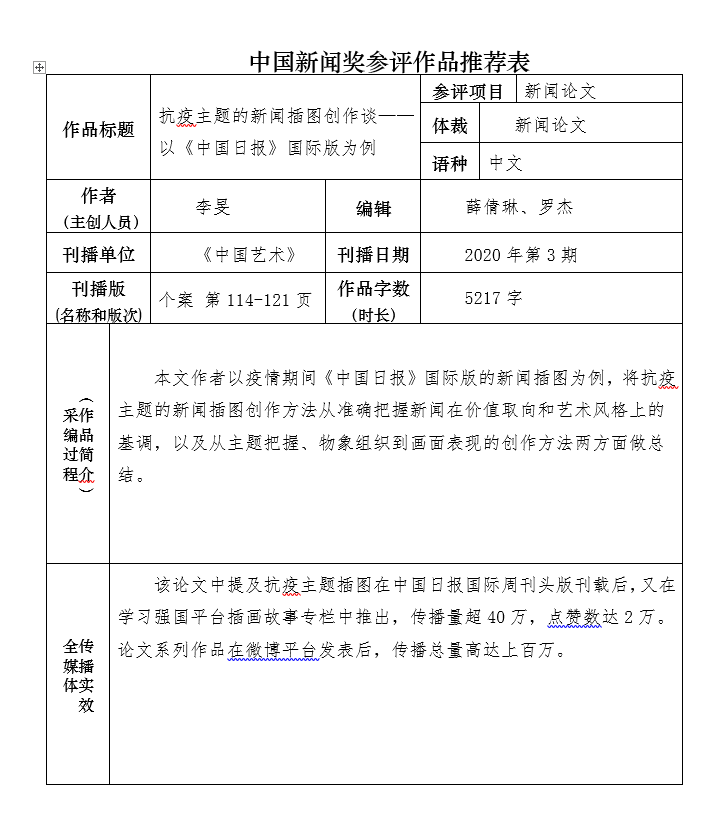
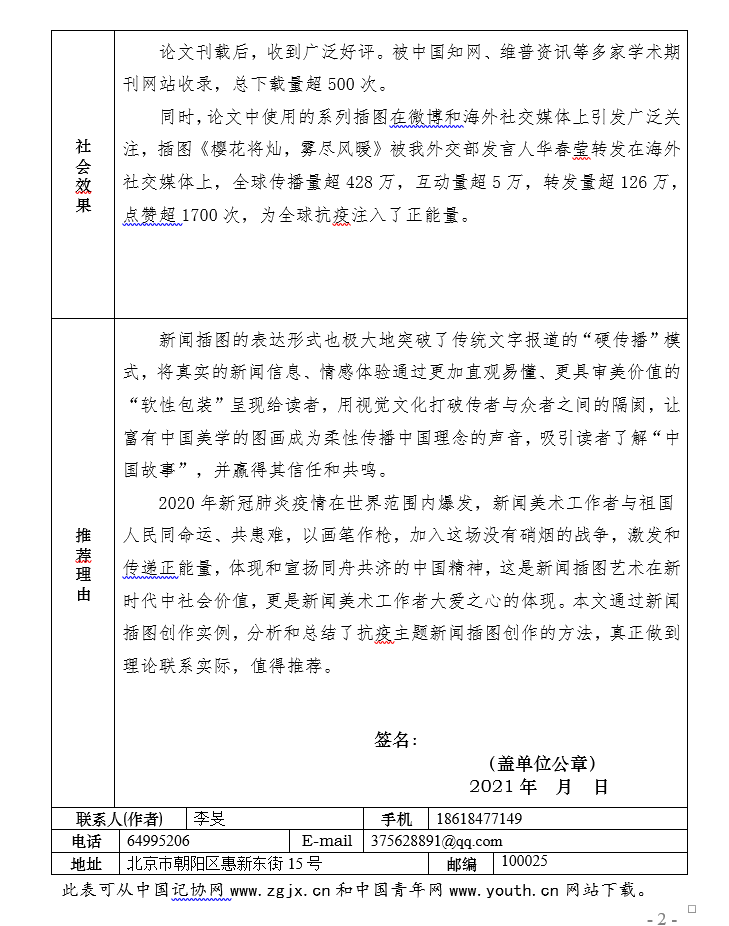
原文:
抗疫主题的新闻插图设计创作谈
——以《中国日报》国际版为例
The Creation of the News Illustration Design on the Theme of the Anti-epidemic: The International Edition of China Daily
李旻 Li Min
内容摘要:报刊等传统媒体在视觉呈现方式、阅读体验设计上的创新,是广大新闻媒体工作者正在共同地、积极地探索方向。新闻插图,作为一种传统的新闻内容载体,在新时代语境和新媒介环境下有了更多可能性,其传播方式也愈发多元化、创意化,用其特有的方式为传统媒介注入新活力。本文以笔者在疫情期间为《中国日报》国际周刊创作的新闻插图为例,将抗疫主题的新闻插图创作方法从准确把握新闻插图在价值取向和艺术风格上的基调,以及从主题把握、物象组织到画面表现的创作方法两方面做总结。
关键词:抗疫主题 新闻插图设计 创作 《中国日报》国际版
“为传统媒介注入新活力”是新闻工作者在新时代语境和新媒介环境下的共同目标。“读图时代”的到来,引发了以“图像转向”为内核的阅读嬗变和传统纸媒的转型,多种信息载体的出现让阅读有了更多可能性,其传播方式也愈发多元化、创意化。对新闻插图的有效运用不仅可以吸引更多的读者、加速新闻传播的效率、提高新闻传播的效果,提升报刊的视觉冲击力、识别性和审美特质,还能在普及大众审美、满足大众日益提高的审美需求方面发挥不容小觑的作用。
《中国日报》(China Daily)是“中国走向世界、世界了解中国的重要窗口,是国内外高端人士首选的中国英文媒体”[1],“对外传播中国声音”“讲好中国故事”是其宗旨。自创刊以来,《中国日报》就因精美的头版插图广受关注和热议。这些新闻插图技法精湛、形式创新,赋予了刊物较强的辨识度,饱含中国传统艺术的韵味,又兼具现代插图的表现手法、审美特征和色彩趋势,与大幅的版面空间相结合,形成了强劲的视觉冲击力。它们甚至可以作为独立的艺术作品存在,可以说,在“为传统媒介注入新活力” 方面做出了不斐的成绩。
众所周知,2020 年新冠肺炎疫情在世界范围内暴发。在这样的关头,新闻美术工作者需要拿出奋战在一线的状态,将真实准确的新闻信息通过直观易读的新闻插图呈现给读者,用视觉化的方式消除群众的疑虑,传递信任、信心和温暖。以下,笔者以疫情期间为《中国日报》国际周刊创作的新闻插图为例,将疫情防控常态化局面下新闻插图创作的方法总结如下。
一、准确把握新闻插图在价值取向和艺术风格上的基调
1.符合时代美学精神的价值取向
在新时代进行艺术创作,尤其是新闻插图创作,要紧扣时代的审美和精神,才能履行好时代所赋予新闻工作者的历史使命。
以抗疫为主题进行创作,如果没有真实可靠的事实依据和真情实感,便容易陷于概念化和口号化的表达之中,从而使形象失去生命力,画面失去感染力。艺术创作要避免人云亦云,更不应为了蹭热度而敷衍了事。创作者要紧扣时代的脉搏,发掘内心的真情实感,并将其用易引起读者共鸣的艺术形象、艺术元素和技术手法展现出来。新闻插图注重冲击力和感染力,这些都需要以具体且鲜活的形象为载体,正可谓“立象以尽意”。
2020 年 5 月 8 日,《中国日报》国际周刊的头版文章报道的是,面对突如其来的疫情,一群可爱可敬的乡村教师给孩子们带去依靠与希望的故事。
画面左边是一位身着红色衣衫的典型中国乡村教师形象,她双手捧书伸向画面右侧,“L”形的构图将整个画面凝聚起来。她望向读者,眼神清澈、执著,这是作品的画眼。分散在教师臂膀周围的是四名乡村里的孩子,他们懵懂、憧憬的神态见者心怜。画面背景是绵延不尽的典型的中国风格的乡村房舍和田野,创作者抛弃了景物的客观色彩,大胆运用与整体画面相协调的辅助色系,将画面的气氛烘托得扎实、浓厚。
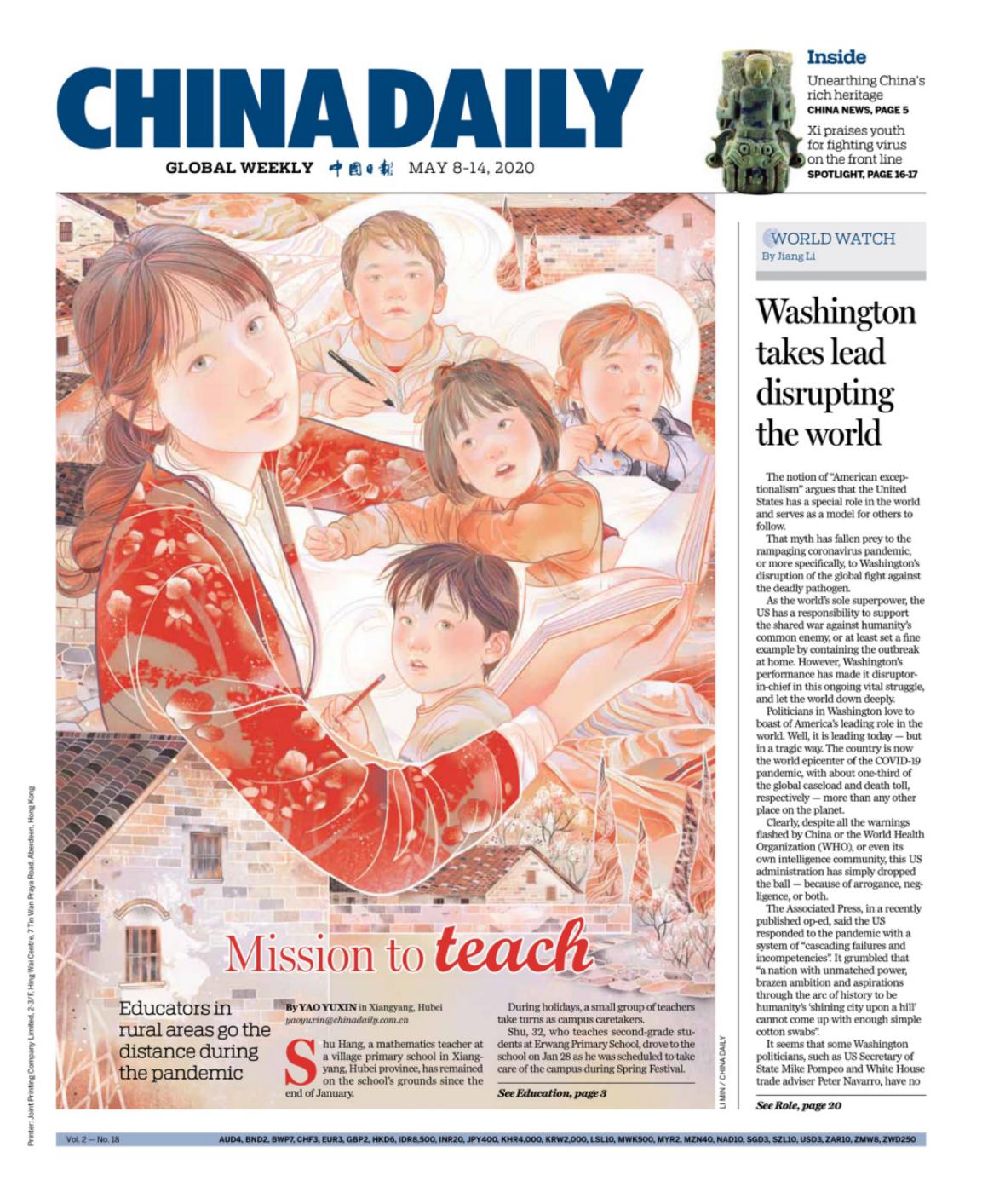

头版插图《小村大爱》
2.以中国元素为基调的艺术风格
“对外传播中国声音”“讲好中国故事”依靠的不仅是新闻内容的文字表述,还要依靠直观作用于视觉的画面元素来传达中国的气息和特质,即用中国风格的视觉元素来强化新闻文字的力量。
笔者毕业于清华大学美术学院视觉传达设计系,该专业继承了老一辈艺术家,如张仃、张光宇等先生的教育思想,十分强调对于图案的训练,“一方面强调中国古代的传统的视觉形式,另一方面又学习借鉴西方现代的表现手法”。因此,笔者在校学习期间接受过一定的图案训练,也学习过传统装饰艺术课程,如临摹敦煌壁画等。现在想来,那时从基础性训练到较为深入和专业的内容学习是十分有必要的,这些掌握了的知识和技巧会融进潜意识,进而变成创作者提升画面水平的能力。参加工作后,笔者还出于个人兴趣在故宫博物院学习过一段时间的工笔画,在之后的插图创作中开始关注和利用线条来造型。
2020 年 4 月 10 日,《中国日报》国际周刊策划了“中日韩三国携手抗疫”的新闻头版内容,头版插图《守护》是完全基于该主题创作的。
该作品工笔画风格浓厚,装饰感强,画面色调以橙和粉为主,搭配蓝灰和紫色调的冷色系,清新治愈。位于画面中心位置的是一位身着和服、编盘发髻的日本少女,她的身上、头上樱花锦簇,象征着美好与希望。日本少女身后左侧是一位手捧一只相思鸟、眉目低垂、身着中式对襟衣衫的中国女性,温婉中流露出人性的关怀。日本少女身后右侧是一位身着韩式传统服装的翩翩少年,他的左手伸向画面右下角,将读者的目光引领至画面的前景处,在这里,中、日、韩三国的医护人员正携手同行、奋战在抗疫第一线。繁花环绕,医护工作者的身影熠熠生辉。画面中丰富的元素均直观地传达出这期主题需要传达的信息。
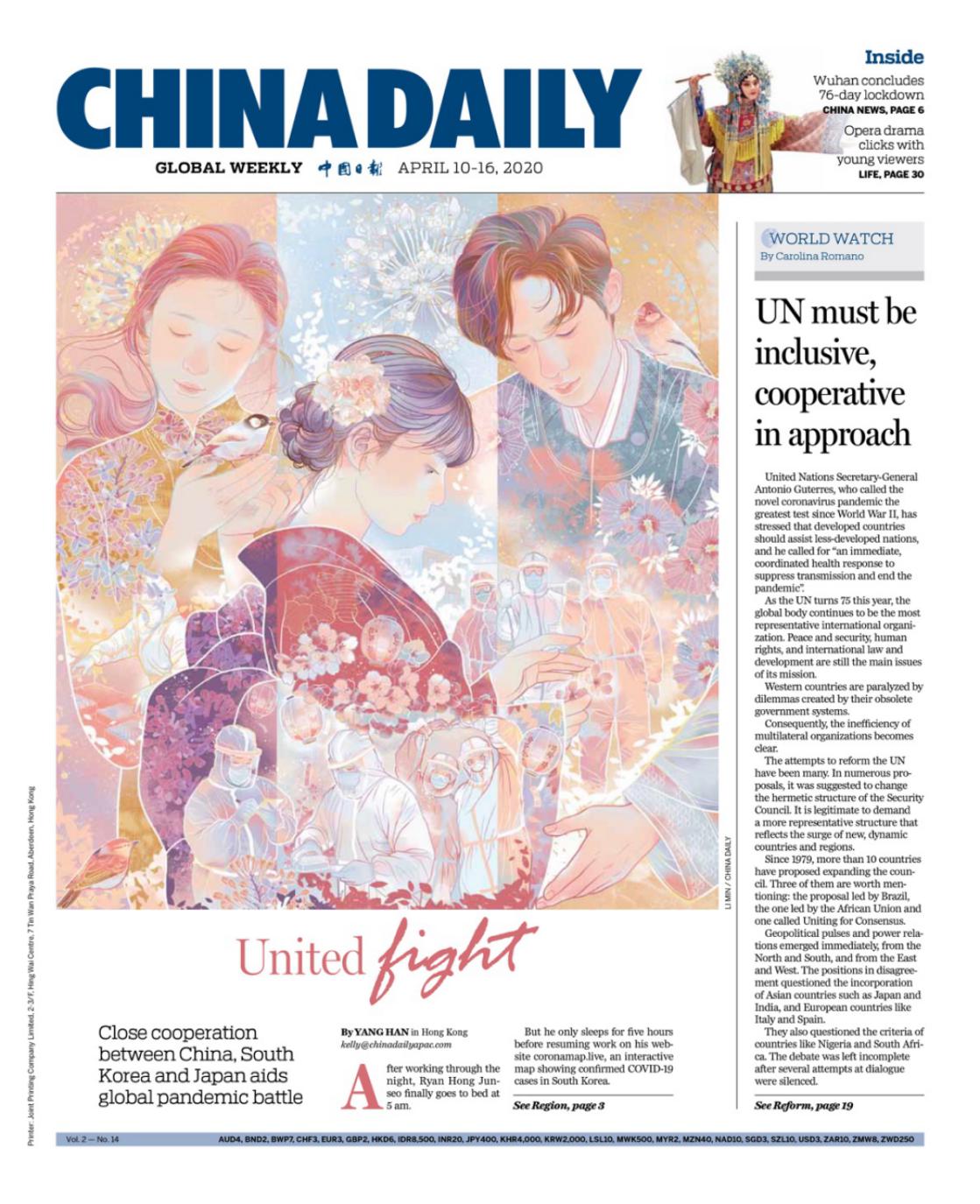

头版插图《守护》
3.合理有效地发挥艺术想象力
新闻报道注重真实、客观地反映事件本身。符合事态发展的真实状态,表现客观环境下的真情实感,是新闻插图艺术创作的基本要求。不过,这并不意味着新闻插图的创作就要完全再现或照搬场景,缺乏想象力和艺术创造力的作品很难使读者产生共鸣,其传播效果也会大打折扣。新闻插图创作可以突破直白、写实的场景描绘,在画面中加入意象性视觉元素,赋予画面装饰性的美感。除了在物象的选择上要符合新闻主题外,用艺术化且想象力丰富的元素符号烘托整体画面效果,从细节中提升作品的艺术品质。
2020 年 4 月 3 日,《中国日报》国际周刊头版新闻主题是疫情时期人们用音乐传递爱与力量,用音乐抚慰心灵。画面中,用音符组成的蒲公英形象漫天飞舞,预示着温暖与希望会像蒲公英一样,随风而动,轻柔地围绕在我们身边,给人们以润物无声的安慰。男孩和女孩在各自的隔离空间中聆听音乐,思绪仿佛乘着朵朵蒲公英遨游世界,整个画面亦实亦虚,诗意盎然。


头版插图《音乐之声》
二、从主题把握、物象组织到画面表现的创作方法
1.与编辑思路相协调,把握主题兼顾创作自由
新闻内容的有效传播是文字和图像合力作用的结果。新闻插图最重要的目的就是辅助新闻内容的传播。而在现实工作中,插画师与编辑往往会在主题视觉化上存在分歧。插画师较为在意的是,对表现对象的生动刻画和画面的美观度,而编辑首要考虑的是依据文字内容来限定画面元素。思维方式和关注点会对插图创作的最终效果产生关键影响。因此,插画师与编辑的深度沟通就十分有必要了。如果插画师与编辑能够就视觉呈现方式达成默契,新闻插图依托于文字内容,又不局限于文字内容,能够拥有一定的创作独立性,那么,新闻插图的艺术价值就能得到很大的提升,甚至具有独立的艺术价值,否则被文字限制起来,其艺术价值也会大打折扣。
自抗疫之初,《中国日报》便着重策划、报道与疫情相关的新闻事件,全方位报道疫情发展态势,宣扬中国抗疫的决心。2020 年 3 月 20 日,《中国日报》国际周刊头版主题是“人工智能助力抗疫”。在这场没有硝烟的战争中,人工智能机器人陆续上岗,大显身手。插图《机器人护士》的视觉中心选取的是一位病患女孩形象,女孩背后的窗外春花烂漫,而病房里,人工智能机器人从各处伸出援助之手,有送药的、送餐饮的、扎辫子的……她的右手比出代表胜利的“V”形手势,展现出病患个体对于战胜病魔的乐观态度和坚定信心。
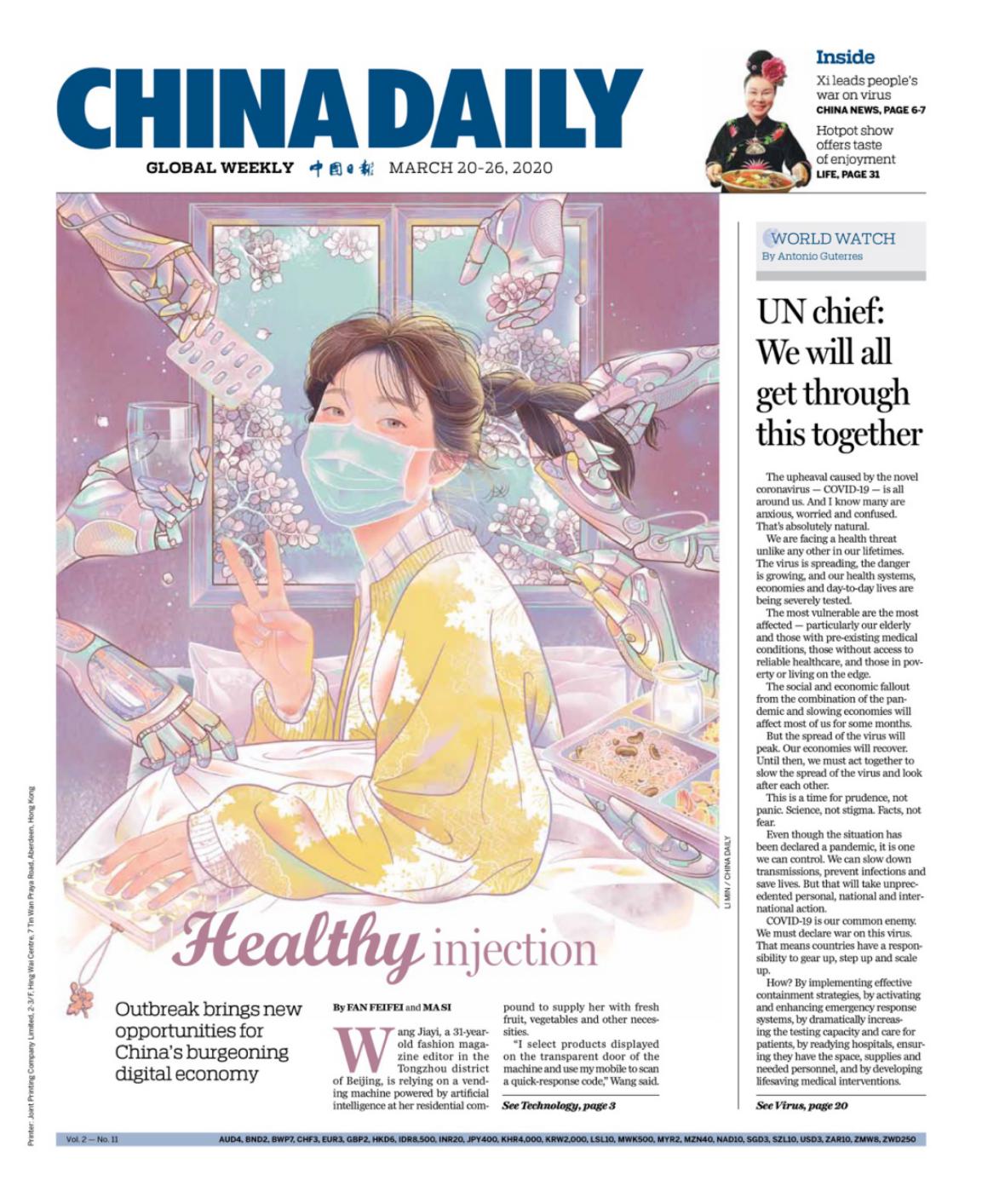

头版插图《机器人护士》
2.物象组织:选择、提炼和层次
主题突出、物象刻画生动、感情渲染到位的作品,才能真正打动读者,而想要做到这一点,对于物象的选择与提炼、关系处理与排列就显得十分重要了。新闻插图中呈现的物象需要既丰富又概括,丰富的物象有利于新闻主题的诠释和画面的丰满,单一的物象较难将复杂的情节和情绪表达得有层次。但简单粗暴地、不加概括地堆叠所有物象易使画面显得混乱复杂,很难抓住读者眼球,甚至令人生厌。
利用物像排列的形式形成视觉中心点,运用艺术化的手法处理主次物象之间的空间、大小、虚实关系,并适当夸大对比,强化画面层次感和张力,增加作品的震撼力。尤其是在表现抗疫题材的作品时,这样的艺术处理方式非常有利于传达新闻主题所暗含的精神。
2020 年 6 月,《中国日报》国际周刊策划了一期以中国助力非洲抗击疫情的头版内容,在插图表现上采用的是具有浓郁非洲风情的元素进行穿插和排列,并最终利用正负形的形式将插图与版面文字编辑组合,画面的主体——非洲女子的头巾为非洲版图形状,它正好为新闻文字提供了位置空间。
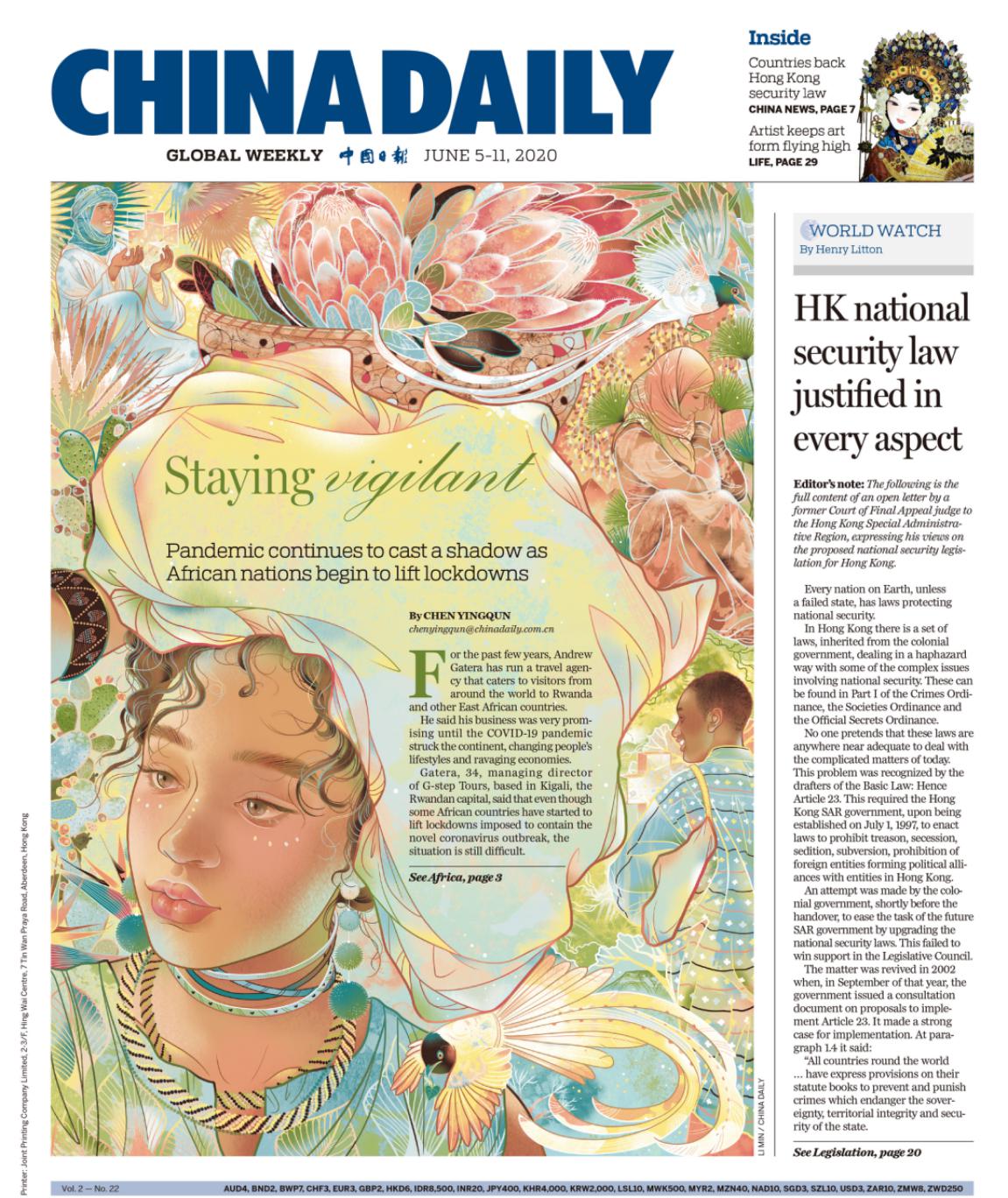

头版插图《爱无国界》
3.画面表现:形象塑造、艺术表现和版面协调
具备了成熟且理想的画面组织方案,还需要将其通过具体且深入的画面表现技法表现出来,并与报刊的整体版式设计相协调,才能说是一件完成、完整的新闻插图作品。新闻插图的艺术表现方式大致可分为形象塑造、艺术表现和版面协调三个方面。
读者受众为海外群体的《中国日报》是中国走向世界、世界了解中国的重要窗口,因此可以说,它要塑造的是面向世界的中国国家形象,其重要性不言而喻。而想要透过对个体形象的塑造来传达国家的整体形象,就需要遵守“主题先行”的原则,按照新闻主题的需要约定个体特征、寻找典型形象。其实,通过观察我们可以发现,同类新闻媒体上出现的典型人物具有很多共性。此外,从技术层面来讲,真实生动的形象塑造需要经过长期的艺术实践和生活沉淀才能做到笔到意达。因此,长期、勤奋的训练和实践是作品成功的基石。
典型真实的形象塑造是一方面,有审美的艺术表现和版面设计也很关键。新闻插图的艺术表现对象主要包括色彩、位置、比例等元素,对这些元素的经营往往是与报刊的整体版面设计相同步的。色彩在承载情绪、烘托氛围、引导体验等方面的能力自不必赘述,画面元素的位置和比例也决定着读者接收新闻信息的次序和强度。新闻插图的载体是报刊,合理、协调的画面表现和版面设计,能展现出报刊良好的艺术品位。因此,采用鲜活的画面表现手法和层次分明的版面布局,有利于营造出美好的憧憬与阅读氛围,有利于提升报刊整体的视觉效果和艺术水平。
疫情主题海报设计《樱花将灿,雾尽风暖》就是利用人物形象塑造、有层次的画面构图和唯美治愈的色彩搭配,表现了人们盼望疫情早日过去的美好愿景。
此外,在新媒体时代,数字技术改变了绘画的创作方式。曾经的报刊杂志插图多为手绘,不易更改且难以再次利用,而现在的插图创作或是手绘线稿、线稿上色等全部由电脑绘制完成,修改、调整灵活便捷,效率和效果均获得了质的提升。

疫情主题海报设计——《樱花将灿,雾尽风暖》
4.作品背后:精神和信念的物化
新闻功能,是指新闻传播媒介对人类社会生活中所产生的有利作用,它会对社会道德产生重大影响。一般报道新闻致力于消除受众的不确定性,反映和指导舆论。[2] 也就是说,新闻要求报道真实的事实。那么,新闻插图就是要塑造生动且深入人心的真实的典型形象,设计构思具有审美层次且便于信息传达的画面,展现现实生活中的真善美,在实现新闻传播的过程中实现引导大众审美的功能。
其实,这与艺术的追求不谋而合,罗丹认为,艺术的真谛不是悦目,而是追求真实。新闻插图创作所讲求的真实包含两个方面,一是指作品要客观呈现事件的真实面貌,二是新闻插图创作者在创作时要做最真实的自己,表达最真实的情感。
此外,新闻插图创作不只是对真实客观物象的抽象和升华以及技巧的展现,还应该是人的情感反映。新闻插图应将肉眼不可见的精神、信念等物质化并加以表现,即用有形的物质传达无形的精神。
三、结语
面对形势严峻的新冠肺炎疫情,新闻美术工作者虽不能奋战在一线,但宣传的力量不可小觑。新闻内容可以传播真实的事态和准确的信息,进而消除群众的疑虑,反映和指导舆论;而新闻插图可以让新闻的功能得以更有效、更深入人心的达成,艺术化的新闻插图能够直接作用于人们的内心,潜移默化地影响人们的心理,传递积极的信念并引导大众审美。
插图,尤其是新闻插图,在不同的时代中、不同的主题下、不同的载体上,以及面对不同的读者时,其功能性和传播特点也有很大差异。在新时代语境和新媒介环境下,对于新闻插图来说,应顺势而为、应时而变,有效发挥其特有的功能,吸引更多读者关注、加速和提升新闻传播的效率和效果,提升报刊的视觉冲击力、识别性和审美特质,并在普及大众审美、满足大众日益提高的审美需求方面发挥应有的作用。
(李旻/中国日报社)
注释:
[1] 资料来源:中国日报中文网, http://www.chinadaily.com.cn/static_c/gyzgrbwz.html.
[2] 童兵 , 陈绚 . 新闻传播学大辞典 [M].北京 : 中国大百科全书出版社 ,2014:5.